Rifts World Book 16: Federation of Magic by Alien Rope Burn
"Poor Peter."
Original SA postRifts World Book 16: Federation of Magic posted:
Warning!

Rifts World Book 16: Federation of Magic posted:
Violence and the Supernatural

Rifts World Book 16: Federation of Magic posted:
The fictional World of Rifts@ is violent, deadly and filled with supernatural monsters. Other dimensional beings, often referred to as “demons,” torment, stalk and prey on humans. Other alien life forms, monsters, gods and demigod, as well as magic, insanity, and war are all elements in this book.

Rifts World Book 16: Federation of Magic posted:
Some parents may find the violence, magic and supernatural elements of the game inappropriate for young readers/players. We suggest parental discretion.

Rifts World Book 16: Federation of Magic posted:
Please note that none of us at Palladium Books@ condone or encourage the occult, the practice of magic, the use of drugs, or violence.

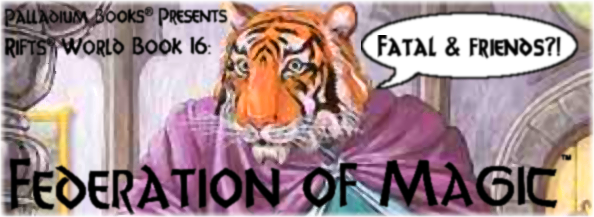
Rifts World Book 16: Federation of Magic, Part One: "Poor Peter."
So, you know the story. Peter Murphy submits a manuscript. Kevin reads it and likes it, but then forgets to get back to him, decides to rewrite much of it, and apologizes in the introduction. Nonetheless, he does compliment him on it, as well as the vague contributions of Doug Coughler and Chris Kornmann. There's also an second apology as he had previously said that Federation of Magic would have been an index for all the myriad forms of magic up until this point except shaman magic (elemental magic, herb magic, temporal magic, tribal magic, and necromancy) but that there wasn't enough time. However, he promises more books on the Magic Zone and Federation of Magic that have never arrived, though Rifts World Book 12: Psyscape will expand the region a bit. The more things change...
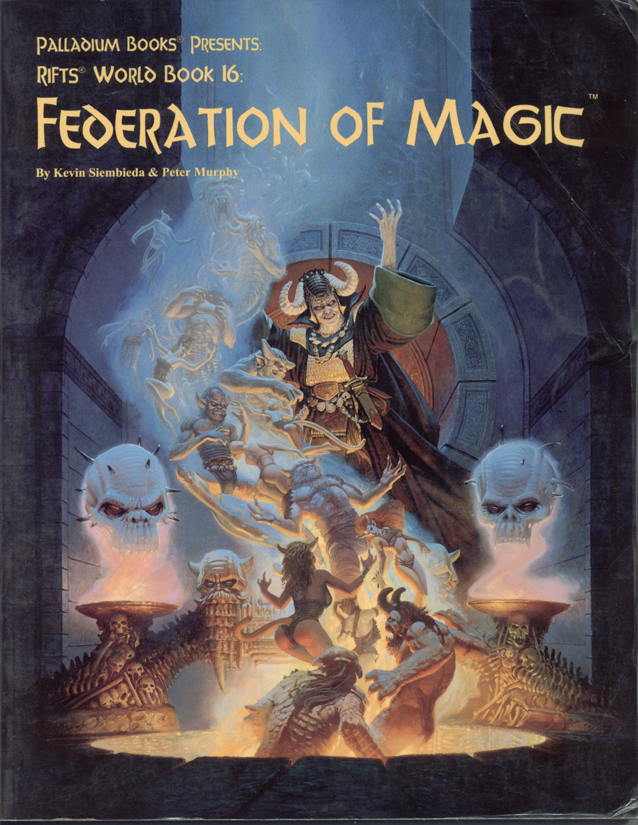
"Rise, tiny people!"
Rifts World Book 16: Federation of Magic posted:
Please Note
The magic spells, powers, people and monsters described in this (or any Palladium RPG) hooks are works of fiction. They are not real. Although some elements may have been inspired by myths and legend, as well as fairy tales, books, movies, and the authors’ own fertile imaginations, the magic and monsters are not “real.” You cannot take anything from this role-playing game book to summon forth demons, travel through a dimensional portal, turn invisible, weave a curse, or anything else magical (other than the magic of friendship and using one’s imagination to have fun).
These are games. Entertainment. Fictional works made to excite and stimulate the reader’s/player’s imagination and to help build fun, new RPG adventures. Please don’t lose sight of that. If you start to think any aspect of these games are “real” and they start to affect your life, you should stop and talk to a parent, uncle, priest, psychologist, or somebody who can help you see reality and work through your fears and problems.
I know there are those of our readers who dislike these disclaimers and statements of what may seem obvious fact, but we, at Palladium, feel they are important. That having been said, read on and enjoy the ideas, wild tales and game to its fullest. We hope you have even more fun playing this stuff than we had writing it.
- Kevin Siembieda, Author & Publisher
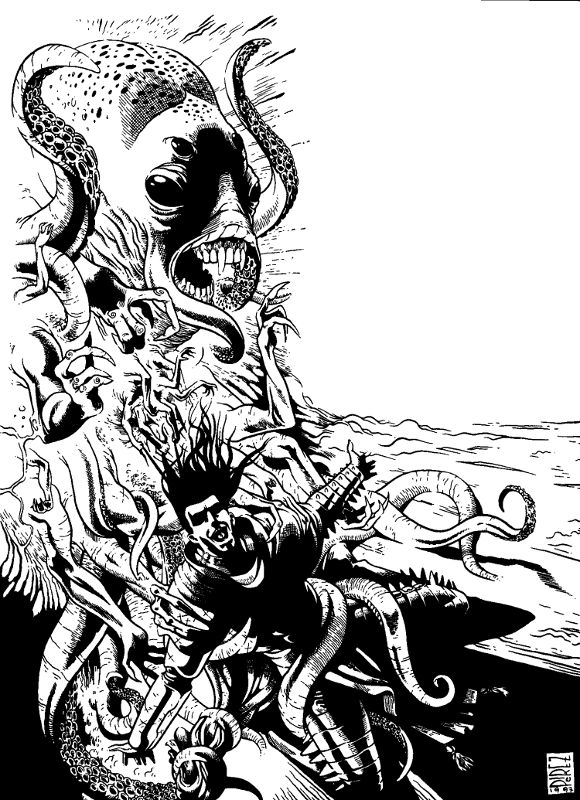
"Hugs!"
In 2003, there will be a revised version of Federation of Magic, one of the few times Palladium actually updates a Rifts book. This is seemingly because most of the magic information in this book gets reprinted in the later Rifts Book of Magic, though Rifts World Book 16: Federation of Magic never explains the revision itself within its pages. Mind, no other book that gets heavily reprinted in Book of Magic gets a revision, so it's rather unclear. In any case, I'll be skipping it for now, as part of it deals with metaplot details that won't be relevant until the conclusion of the Coalition Wars series, and I just need to keep moving on to the next book.
Lastly, we get some Ramon Perez art that goes some way to show "Dungeonpunk" predating d20 with some interesting, odd designs for mages in this. Practical? Probably not, but given we haven't really seen some distinctive spellcaster designs since the corebook, it's a welcome addition.
Next: The Gathering.
"Among the most notable of the 134 requests to have been made that day, was for Lord Dunscon to forbid the summoning or association with so-called demons, dragons, elementals, aliens and supernatural forces."
Original SA post
Rifts World Book 16: Federation of Magic, Part Two: "Among the most notable of the 134 requests to have been made that day, was for Lord Dunscon to forbid the summoning or association with so-called demons, dragons, elementals, aliens and supernatural forces."
The Federation of Magic
So, we're told the (re)study of magic in this post-apocalyptic Earth is still in its infancy, partly because magic has often become demonized. This is due to corruption, but also due to the predations of literal demons. However, though magic often seems to turn people to evil, it's emphasized that it's not an evil force, and it's more likely that humanity corrupts magic with negative emotions than magic corrupting humanity.
With that established, the Federation of Magic has a lot of contradictory rumors praising it or demonizing it we don't need to get into, but as we establish what it's about, it'll be clear why people might have contradictory attitudes towards it. Though previously it's been painted as a purely villainous organization, it turns out to be more multifacteted than previously discussed.
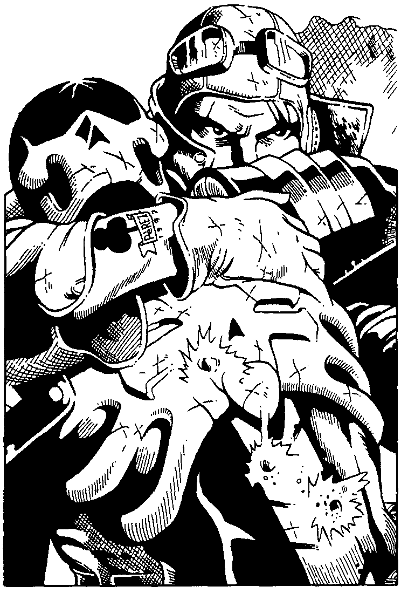
"Hugs!"
A Promising Beginning...
So, in the early days of magic, magic-users were often shunned from their communities, and wayward wizards began to form together into the "First Magic Kingdoms" - Lazlo (a democratic magic utopia), Tolkeen (a neutral magic monarchy), and the Federation of Magic (a dictatorial magic confederacy). The latter kingdom will be the focus, of course - Tolkeen was technically part of the Federation of Magic, but they'll eventually break away. Instead, we start with the story of a "Grand City" in the ruins of Chicago, not far from the fledgling Chi-Town, led by a powerful mage named Nostrous Dunscon. This was before the Proseks had taken power and made Chi-Town into a fascist state, and before magic was banned. Chi-Town was very wary of the supernatural and sorcery, but had yet to ban magic entirely.
When the Coalition States were formed with Chi-Town as the leader, Nostrous took offense, presuming it as a slight or a mistake that the Federation of Magic hadn't been invited for membership. The Coalition saw the Federation of Magic's liberal magic policies as extremely concerning, and had never intended to offer them membership. Still, they agreed to a meeting with Dunscon. Chi-Town's leadership offered to open up trade and an embassy if only the Federation of Magic would fulfill a undetailed list of 134 requests, most of them restricting magic and banning association with supernatural powers. The implication is that the Coalition were just going through the motions and had no intention of a proper offer, but it's not really clear if they're being intentionally unreasonable or just bullheaded. Dunscon instantly dismissed the offer vehemently as a joke, gave them a tongue-lashing about the power of magic and his kingdom and various "rue the day" declarations, then teleported away. Though alarmed, the Coalition leadership agreed to leave things be. However, Dunscon stewed, formulating plans to knock over Chi-Town and then take over North America as a whole. The wizard could not let the insult go, and began gathering his army.
Low-intensity conflicts increased tensions, eventually leading up to the Battle of Chi-Town. Dunscon assaulted Chi-Town in force, grossly underestimating the Coalition defenders on multiple levels, expecting them to falter or break through sheer force. Though losses were immense on both sides, Dunscon's army was crushed by the Coaltion's superior numbers and tactics, and retreated. Chi-Town's army pursued, led by Joseph Prosek, the future father of Karl Prosek (the current leader of the Coalition). Joseph led a "Campaign of Blood" in which they exterminated tens of thousands of spellcasters and their "accomplices", blew the hell out of the Grand city, and Prosek finally tracked down and killed Dunscon personally, ending the campaign. Why Dunscon couldn't just teleport in assassins to destroy most of the Coalition leadership is, of course, never answered - people just always fight like ground-pounding infantry in this setting, irregardless of the fact that there are jet fighters and invisible demons involved.
Much of the Federation had never seen eye-to-eye with Dunscon's dreams of conquest, and so many members fled the Coalition counteroffensive, traveling to the Magic Zone and settling down there. Tolkeen broke ties with the Federation of Magic, becoming independent. We get Erin Tarn's take on the whole thing, but most of it is just slight more detail on what we already knew from the initial description. Lastly, we get some handwringing from Tarn about how things might have been different if Dunscon was less arrogant or Prosek was less bloodthirsty, and points the blame largely upon their actions and attitudes in a very "Great Man Theory" view of the aforementioned events.
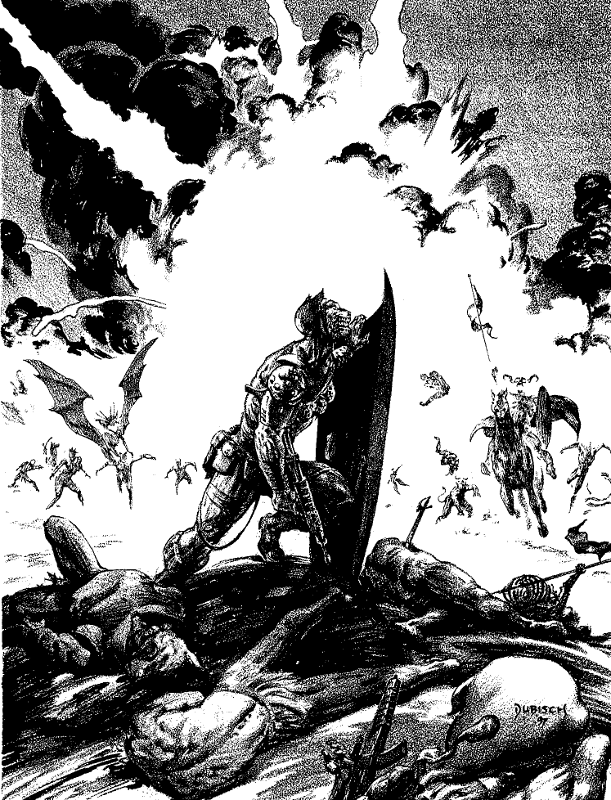
Depicted here: the Coalition vs. the Fed... er... where's the Coalition?
The Federation of Today
So, nowadays the "Federation" is a very loose-knit group of city-states, organizations, and small communities mostly just connected through their common existence in the Magic Zone (a magic-rich area throughout Ohio and Kentucky) or though their general reliance on magic. Nowadays, there are two forces who at least lead the largest factions of the Federation - Alistair Dunscon (Nostrous' vengeful son) and the Lords of Magic (three mysterious magic-dominating gods). While the Lords of Magic intended to take over the Federation of Magic following Dunscon's fall and shepherd it towards a more peaceful future, it was too broken for them to do so. Lastly, we get a fiction chunk where Alistair discovers his father's body and declares revenge, while the Lords of Magic declare they will taking the Federation of Magic in a less violent direction. Alistair throws a tantrum, but ultimately acquiesces... quietly and unsubtly planning later revenge.
Next: It's a magical place.
"In this sense, he is like an oriental guru who teaches inner peace, focus and control."
Original SA post
Rifts World Book 16: Federation of Magic, Part Three: "In this sense, he is like an oriental guru who teaches inner peace, focus and control."
The City of Dweomer
Run by the Lords of Magic, Dweomer is the largest city in the Federation, and the 3rd largest "magic city" in America (with only Tolkeen and Lazlo being larger). Located in southern (former) Ohio, magic hides it away from prying eyes. Despite this, it accepts nearly anyone invited, and only exceptions are the undead (including vampires), known cannibals, necromancers, and witches (of the demonic pact sort). Necromancy, bio-wizardry, rune magic, and witchery are banned, but just about every other type of sorcery is practiced. However, psychics are frowned upon for unstated reasons, and occasionally persecuted unfairly. Psi-Stalkers in particular are treated badly due to their reputation for "hunting" sorcerers. Otherwise, any being is accepted - even demons and monsters, as long they don't go around eating people or making human sacrifices. Most major crimes are punished by banishment, but revolutionary activities against magical organizations or the Lords of magic are punished by execution.
Dweomer is magically cloaked away through a series of illusions regularly maintained by the inhabitants, and the region is heavily patrolled for those who might stumble across the city. A fair number of Federation members know about it, and one can be invited, but those who attempt to reveal the secret are banished; those that actively try and spread their secrets widely are assassinated. (Granted, I don't know how they'd keep track on that sort of thing hundreds or thousands of miles from the city, but what's what we're told.) Even if you know where it is, the illusions are supposed to stymie you if you're not cleared for entry. Dweomer Defense Patrols (DDP) mainly try and use illusions to divert those who might stumble across the city or drive them off otherwise, and eliminate them if they have no choice. Remarkably, we're told DDP officers are around a ridiculous 8th - 12th level even they would seem to only have modest experience (given that it's not like they have active military campaigns and are basically Scooby-Dooing people away). Mostly, they just want to avoid open conflict with the Coalition. However, they have a city-doming protective forcefield controlled by a series of towers if it comes to that.
Which makes me wonder - how do they get supplies to keep the city running? Cities generally need a lot of food and other raw materials, which doesn't work if the farmers always get lost on their way to market. And that's to say nothing of having to sell goods manufactured in the city for export. There are a variety of explanations that are possible - maybe they're self-sufficient via magic, maybe they trade with other dimensions, but it's not clear how they stay alive, or indeed what the point of Dweomer is as a city other than a safe haven. It's not a trade center, it's not clearly self-sufficient, etc.
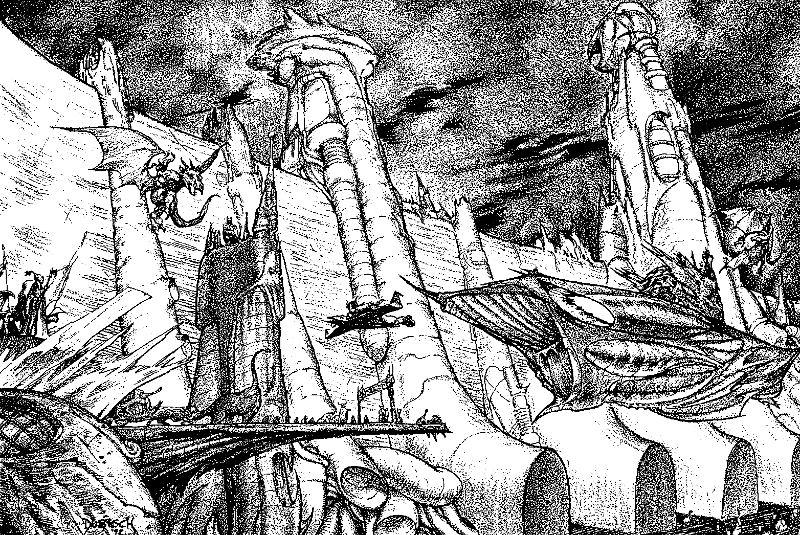
The giant airships and dinosaurs may be tragically apocryphal.
Diplomatic Relations
Dweomer and the Lords of Magic are respected within the Federation of Magic, but are so extremely isolationist that they have little direct impact on the wider region. Alistair Dunscon holds them partially responsible for the death of his father because... uh... they didn't help him fight the Coalition, I guess? In any case, he seeks to destroyyy them! The fools! It's only the fact that he hates the Coalition more that keeps him from revealing Dweomer's location... which doesn't quite follow, wouldn't he want them to fight each other? Well, he is generically nutballs, to use the clinical term. So we shrug and move on. For their part, the Lords of Magic are aware of Alistair's veiled hostility, but sit on their thumbs about it. Indeed, thumb-sitting seems to be their main calling in life.
Ultimately, they're extremely paranoid about being uncovered by the Coalition, but it seems inevitable the Coalition will eventually figure out there's a blank spot their scouts never seem to cover. We're told it may take decades for them to do so, however.
Dweomer's leadership is more immediately concerned about the Cult of Dragonwright (fanatical dragon worshippers from the Palladium Fantasy RPG setting, backed by Atlantis on Earth) and the Grim Reapers (the Death-worshipping Juicer cult from Juicer Uprising) and actively stomp them out). Otherwise, the Lords of Magic generally carry neutrality in their hearts.
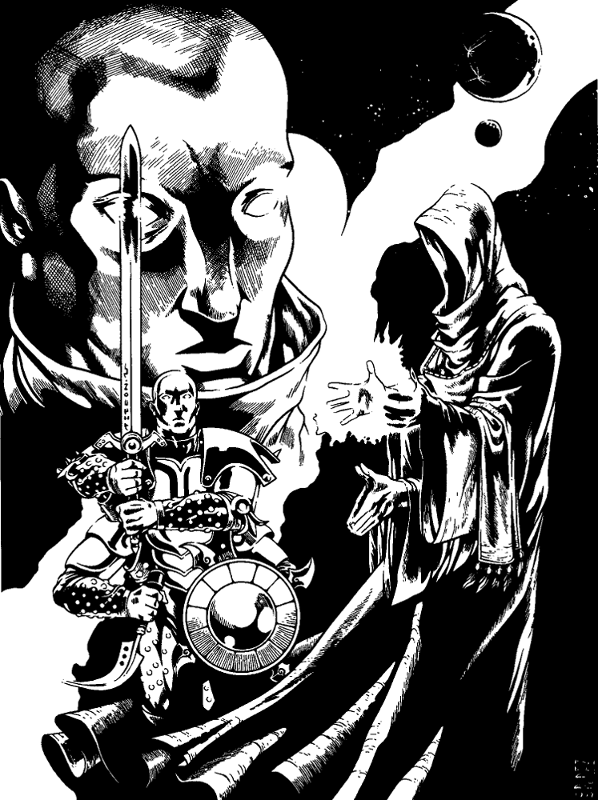
"Now with their hit EP: Neutral Is An Alignment!"
The Lords of Magic
Four-armed golden gods with glowing eyes, the Lords of Magic look like human masculine ideals, or at least the Siembiedan interpretation thereof. They refuse to reveal their origins, but I'm just going to bust up the order of things and discuss here even though it's discussed in Alistair's section, confusingly enough. There are some that think they're related to Rahu-Men (the race of four-armed golden giants from Conversion Book), but it turns out not to be the case... but some Rahu-Men worship them anyway. Most of the residents of Dweomer trust in them having some "grand plan", but if they have a plan other than thumb-sitting, it's not readily apparent.
They get some special mechanics, like the fact that they lose power the further they are away from one another. As such, they have self-confidence issues when apart, and are unlikely to commit to important decisions on their own (as if they commit to much of anything). They also have a weakness to psionic attacks due to a mental instability we'll cover, but are immune to mind control. They're also the only ones with the ability to give life to new Automatons (magic mecha we'll see much more of later). They all have high-level deific statblocks individually, along with access to top-level magic even for deities, living up to their name. There's also references to specific powers they have from Dragons & Gods... a book for Palladium Fantasy, but I draw the line at having to reference other game lines, thanks, so I'm not going to worry about those. Each of them oversees a different type of "magi", which are new O.C.C.s we'll see in just a bit. The three of them are:
- Brethan D’zir, "High Lord Magus, First Among Equals": A benevolent leader most directly involved with ruling the city. he's mainly determined to make sure Dweomer City is a haven for magic and "exploration of the humanoid spirit". He prefers to avoid conflict if possible, but will stand fast in defending the city. He's involved with sponsoring the High Magi.
- Coran D’zir, "High Lord Battler": As you may guess from the subtitle, Coran serves as the warrior and aggressor of the three. The others often have to hold him back, and yet we're told he's a "being of conviction and peace", and to top off the bizarre characterization cherry, he's given an Aberrant (evil) alignment. He's the leader of the Battle Magi of Dweomer, and has a special four-fist punch that expends four attacks to use, but is actively worse than four separate punches.
- Leizak D’zir, "High Lord Creator": The brainiest and wizardiest of the three, we're told he's like an "oriental guru" (please stop using that phrase, Palladium) and teaches the High Magi, as well as overseeing the creation of the Automatons. He's the most obsessed with maintaining Dweomer's security. Though he's a calm "guru" sort, he's becoming more obsessed with anger and retribution against the evil often surrounding them.
Next: Welcome to the City of Brass, Kentucky.
"The ruins of Old Chicago and the southern tip of Lake Michigan are approximately 350 miles (560 km) away, Chi-Town 400 miles (640 km), New Lazlo and the ruins of Old Detroit 400 miles (640 km), Lazlo 600 miles (960 km), Dweomer 200 miles (320 km), the Devil’s Gate (St. Louis) 220 miles (352 km), Fort El Dorado (Arkansas) 500 miles (800 km), the eastem border of the Pecos Empire 800 miles (1280 km), the Mississippi 100 miles (160 km) due west, and the Gulf of Mexico only 500 miles (800 km) due south; all distances are rough approximates and may be a bit off."
Original SA post
Rifts World Book 16: Federation of Magic, Part Four: "The ruins of Old Chicago and the southern tip of Lake Michigan are approximately 350 miles (560 km) away, Chi-Town 400 miles (640 km), New Lazlo and the ruins of Old Detroit 400 miles (640 km), Lazlo 600 miles (960 km), Dweomer 200 miles (320 km), the Devil’s Gate (St. Louis) 220 miles (352 km), Fort El Dorado (Arkansas) 500 miles (800 km), the eastem border of the Pecos Empire 800 miles (1280 km), the Mississippi 100 miles (160 km) due west, and the Gulf of Mexico only 500 miles (800 km) due south; all distances are rough approximates and may be a bit off."
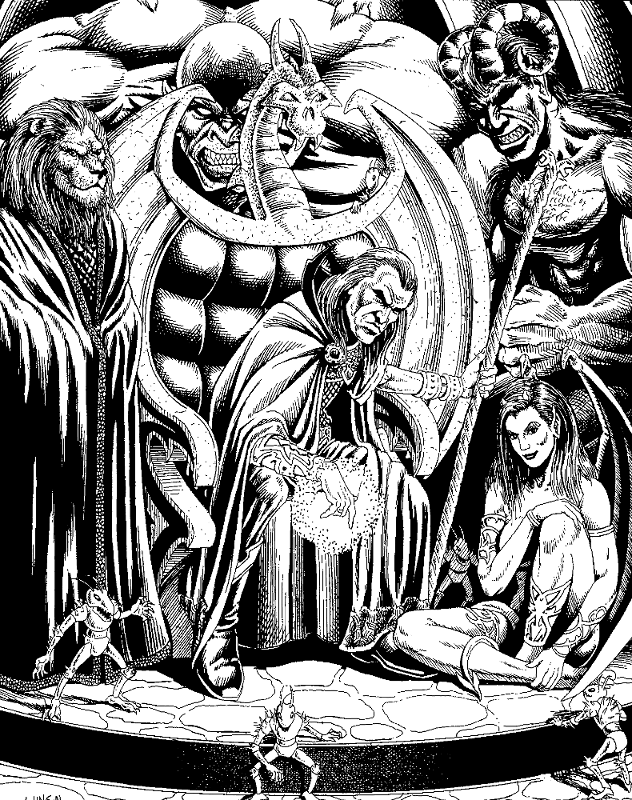
"Come, pull my finger."
The "True" Federation
By Kevin Siembieda with ideas from Peter Murphy
Oh, you thought you might be reading about some location or organization based on the title, right? But you're wrong. It's time for the Alistair Dunscon parade, starring Alistair Dunscon, in honor of Alistair Dunscon. Let's cover all the cool shit Alistair's done since his daddy got his head chopped off by Karl Prosek's daddy!
- Became best buds with Lord Splynncryth, the Splugorth leader of Atlantis, and learned both wizardry and bio-wizardry from him.
- Learned or created out a necromantic ritual of immortality (as long as he sacrifices somebody once a week).
- Returned to the Magic Zone and killed the leaders of a number of magic brotherhoods who he saw as threats to his would-be leadership of the Federation (and also to prove that he was a tough guy who isn't afraid of nothin').
- Apologized to the Lords of Magic but also announced his intent to take over the Federation so they'd best stay out of his way!
- Discovered the City of Brass accidentally, and founded his kingdom on it.
- Gathered a bunch of followers by offering vengeance, dark magic, or both, and declared that he would take revenge against the Coalition.
- Sparked acts of terrorism against the Coalition.
- Alienated a lot of the other members of the Federation of Magic by being the edgelordiest blowhard.
And now:
 A retcon interlude
A retcon interlude 
See, we were previously told that a terrorist attack by the Federation of Magic killed Jo-Anna Prosek (Karl Prosek's wife and Joseph Prosek's mom) in 102 P.A., but that turns out to be a lie. She didn't die, she was kidnapped by Alistair Dunscon! (Her son, Jason Prosek, really did die trying to protect her... unless that gets retconned at some point as well.) She would be eventually get rescued by Lord Coake (the head of the Cyber-Knights) and a group of unnamed adventurers. Though she was imprisoned and verbally abused for three years by Alistair, they would pull her out just before Dunscon's first scheduled torture session. Then, they returned her to the Coalition. However, Karl Prosek just regards her capture and rescue it as part of an elaborate scheme to brainwash her, and has zero gratitude towards the Cyber-Knights and her other rescuers. Jo-Anna, however, is now seriously and quietly questioning the Coalition party line.
Apparently, keeping her imprisoned was part of Alistair's scheme to drive Karl to further extremes, increase the persecution of magic users, and bolster his own ranks and propaganda. What a clever guy, that Alistair! I mean, he's obviously too smart to capture a Coalition higher-up and try and actually get information from her, I mean, he only has like hundreds of people with mind-reading and mind control powers, and...
... anyway...
 Retcon over
Retcon over 
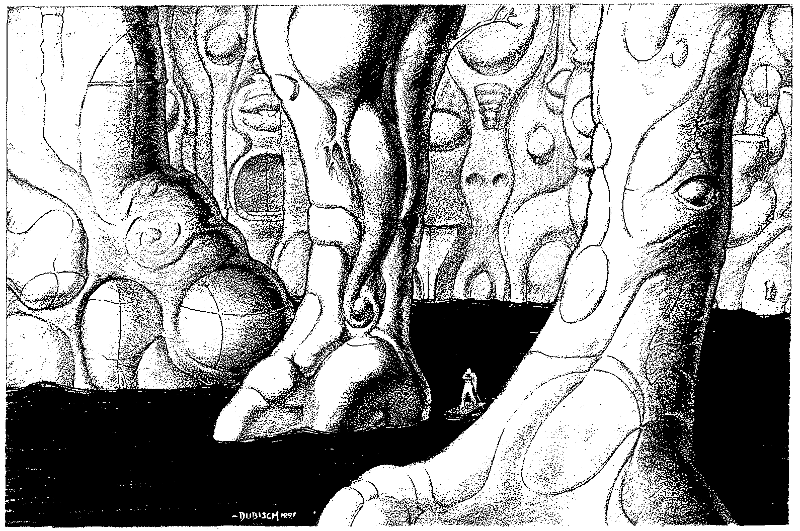
"I don't mind the lake of blood so much, but it's a real pain for my commute."
City of Brass
The City of Brass can be entered at the Mammoth Caves in Kentucky, where they have permanent dimensional portals. The city looks like it's part of the same cave system, but is actually in another dimension. Whadda coinkidink! A seemingly abandoned alien city made of brass-like materials, it's mechanized through mysterious means where various lights, doors, elevators, etc. are accessed through verbal commands or gestures. Though made of metal, the structure seems organic in shape, and mysteriously heals any damage done to it.
Mostly, it's home to bad guys - evil spellcasters, demons, monsters, and all sorts of thugs. Slavery is legal (sometimes slaves are imported from Atlantis) and though violence is discouraged, though human sacrifice is "commonplace". These are basically the generic villains that give the Federation of Magic a bad name, and they all somehow work together reasonably well despite being a horde of selfish pricks. Like in Atlantis or the Phoenix Empire, they seem to all belong to an alignment union where they don't dick each other over too much. It's like we're back to Dungeons & Dragons and its "alignment as a culture" notion.
The Kingdom of Dunscon
But the City of Brass isn't all! We also have Nostrous, a city which is another den of scum and villainy that has brass building trim to try and fool people into thinking it's the City of Brass because [ERROR: REASON NOT FOUND]. It's one of the few centers of Bio-Wizardry outside of Atlantis. There's also Dragon's Blood, a community named that because they murdered a dragon here and took his place!... it's full of necromancers and demons now because blooood. Shadowvillage is run by shifters and temporal raiders (time Dr. Dooms detailed in Rifts World Book 3: England) but some monsters use this a neutral ground. There's also Fort Knox, which was raided long ago but is used solely as a trap by monsters and bandits. Of course, there are also a wide number of small villages and wizarding communities that have declared loyalty to Dunscon.
Diplomatic Relations
Alistair has offered publicly to support Tolkeen in the upcoming war against the Coalition, but intends to back out at the last minute and let the Coalition destroy them as revenge for them leaving the Federation decades ago. He ultimately wants to see Dweomer destroyed, but might save them from the Coalition to earn good PR if he can. He wants to destroy Stormspire but finds them useful... for now. He generally either ignores or has fair-weather alliances with other communities. As if you had to ask, he really, really wants to destroy the Coalition States once he thinks he has a shot.
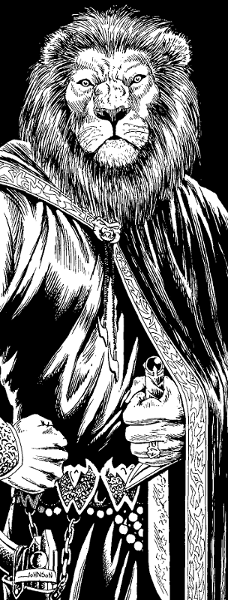
"FATAL & Friends?!"
Notables of the City of Brass
Lord Alistair Dunscon (10th level Ley Line Walker, 8th level Shifter) has a tremendous daddy complex and his plans of revenge are centered around that. Though he's a century old, he only looks thirty due to his form of immortality - not that he's thrilled with the inconvenience the whole "gotta murder a person a week for eternal life" deal. He's a sociopathic megalomanic sadi- fuck, I feel like I need to keep that in my c/p file whenever a Rifts villain comes up. "Sadistic and insane and thinks he's a god? You don't say!" About the only thing that stands out is the fact that he's trying realllly hard to be patient as a newfound immortal, which boils down to thumbsitting (again) and doing little "s" schemes. He gets a litany of magical items and special powers and goodies, as one of the top baddies of the setting, but he's at least not loaded down with more than a few dozen M.D.C. We also get a number of fully-statted minions for him:
- Bloodmist: A lion-headed raksasha who's Dunscon's closest advisor and is rumored to be the power behind the throne, but actually considers Dunscon to be a "most worthy and brilliant master".
 He likes spy games and is pretty much a rubber-stamp raksasha other than his convenient lack of ambition. Oh, and he'll get drawn in the CCG as a tiger, but I guess as a shapeshifter, he can be any kind of cat head he wants. Do a Scottish Fold next, Bloodmist!
He likes spy games and is pretty much a rubber-stamp raksasha other than his convenient lack of ambition. Oh, and he'll get drawn in the CCG as a tiger, but I guess as a shapeshifter, he can be any kind of cat head he wants. Do a Scottish Fold next, Bloodmist!
- Mestoph Danali: Get it, it's a pun.
 As Alistair's enforcer, she's rumored to be the first human of the Corrupt (more on them later) who pledged her soul to "the Liberator". She doesn't seem to have changed much physically or mentally upon becoming a Corrupt, presumably because she was soooo evil already, corruption didn't change her. That feels like it should be more of a punchline than trying to sell her up, but there it is. "Sold my soul, don't feel the difference...?"
As Alistair's enforcer, she's rumored to be the first human of the Corrupt (more on them later) who pledged her soul to "the Liberator". She doesn't seem to have changed much physically or mentally upon becoming a Corrupt, presumably because she was soooo evil already, corruption didn't change her. That feels like it should be more of a punchline than trying to sell her up, but there it is. "Sold my soul, don't feel the difference...?"
- Brok Redman: A Baal-Rog demon (maybe you're heard of them in some novel), he's Alistair's general and generally likes him (inexplicably) but doesn't like the company he keeps.
- Cracius the Cunning: A Deevil of indeterminable type and intdeterminate role, he likes doing one-upmanship with the other servants to show off in front of Alistair, not that he likes him or anything...!
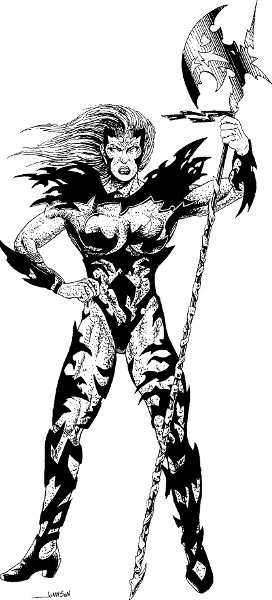
Liberated from a fashion sense, I guess.
And that's that for the most vanilla of darkest evil, and we can move on. I feel like they're cartoonishly exaggerated so the books can be like "Maybe the Coalition isn't so bad makes you think huh." mealy-mouthed nonsense. And it's fine to have two ethically compromised factions to show us that only madmen start terrible wars, if grossly simplistic. The problem is there's no nuance to the "True Federation" beyond Alistair's "they killed my daddy", which immediately just comes across as childish petulance given his father started the whole war and wanted to conquer the world. Their whole ethos against the Coalition comes across as "man, the fascists won't let us do evil magic and fill trash cans with dead babies!" So they're amazingly one-note, and this won't be helped by the fact that they don't even get a tenth of the attention and detail that the Coalition itself does. And whenever they do come up, it's usually "hey, Alistair did an eeevil experiment or summoned an eeevil creature!"
Next: ... and the rest.
"Still they and their Juicer Murder Wraiths linger like a pestilence, striking out at the living in small numbers by creating death and mayhem - the Grim Reapers generally have only one use for other life forms: target practice."
Original SA post
Rifts World Book 16: Federation of Magic, Part Five: "Still they and their Juicer Murder Wraiths linger like a pestilence, striking out at the living in small numbers by creating death and mayhem - the Grim Reapers generally have only one use for other life forms: target practice."
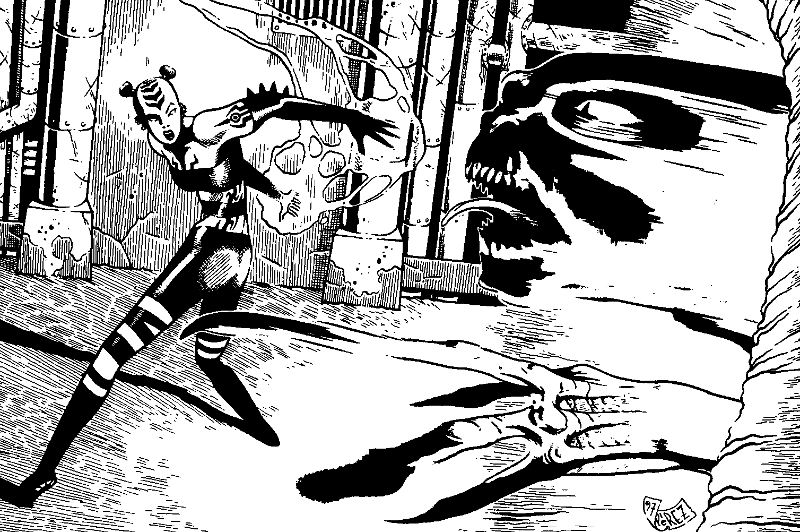
"I've come to tell you spines don't bend that way!" "Nooooo!"
Brotherhoods & Places of Note
Fadetowns
These are towns that "fade" from place to place or just out of existence entirely. We get a random table of effects that can occur there, and apparently people just get used to them, or even prefer them do to becoming temporarily inviolable or the like. (It doesn't really get into how people survive in a period they are cut off from the rest of the world, which I'd think would be an issue.) Most of them are isolated psychologically as well and shun outsiders, but not all - but there's a lot of superstition around them that keeps outsiders away as well.
The Grey Seers
These are mystic monks that specialize in clairvoyance, mainly using it to prevent major disasters. They're "neutral" in a factional sense (not an alignment sense, we know how Siembieda feels about that) and just try to preserve life and deliver truth in about that order. Most people respect them highly, but those who fear the supernatural naturally view them with a more suspicious eye.
The Grim Reapers Cult
The Death-worshippers that reanimate Juicers as undead horrors from Juicer Uprising, so you can look up the details in that review. They work with Lord Dunscon out of necromantic professional courtesy.'
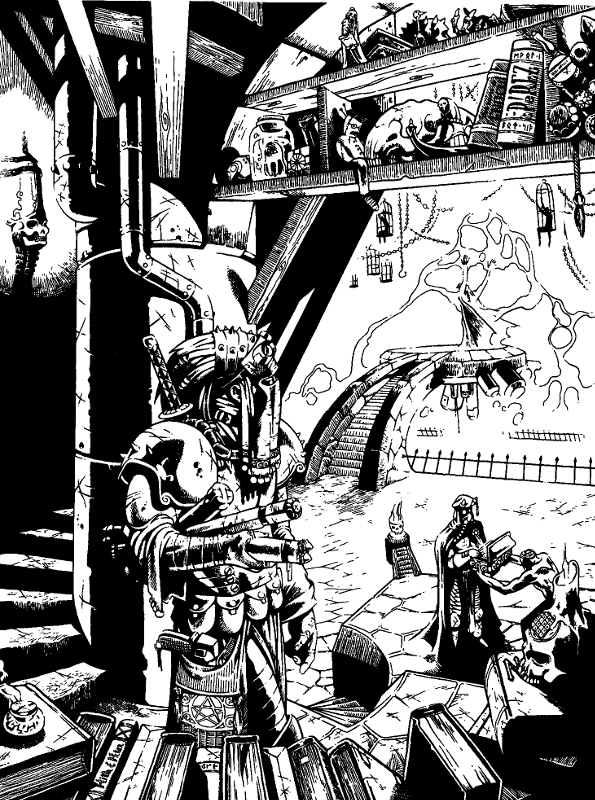
"This is quite the mancave you've got going on."
The Society of Sages
Dragon-hunters that hold the secrets of making Dragon Juicer detailed in - once again - Juicer Uprising. So you can look them up there. Given their leader was exiled from Alistair's "True" Federation of Magic, so they undermine them whenever possible. They're also virulently opposed the Cult of Dragonwright for obvious reasons. Oh, and aforementioned Cult gets another short entry, as some Atlantis-sponsored dragons have taken over some small locales.
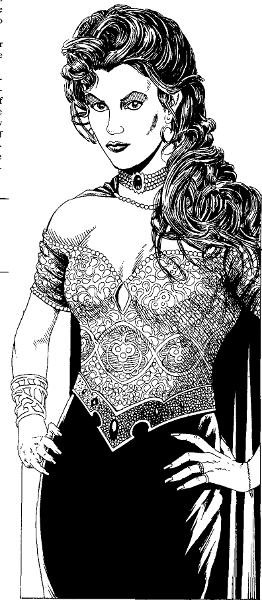
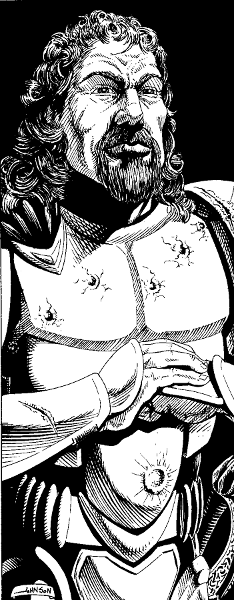
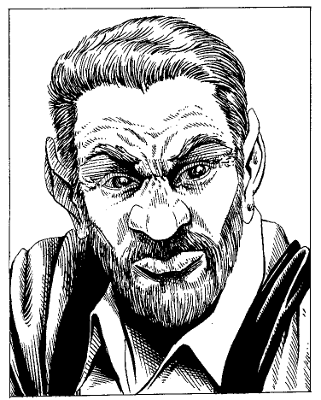
"Order of the Triad, GO!"
Mystic Triad & Magestar
Magestar is as close as we see to a straight-up goody-two shoes town, run by a trio of ex-Dweomer mages called the "Mystic Triad" (no relation to Venture Bros., tragically) who got tired of Dweomer's fence-sitting. They've tried to build a more inclusive community with assistance from the Grey Seers, and their leaders are:
- Kara Zayne: A friendly Lord Magus who believes in the power of magic to help people, but who harbors secret doubts.
- Hugh Madding: A Battle Magus who hopes Magestar will be able to gather a force to oppose the Coalition. Sounds likely.

- Dan Ironforge: A dwarven High Magus who hoped Magestar would mean greater exposure for his craftsmanship compared to Dweomer, but was chagrined to find out most of his time is being taken up by administration.
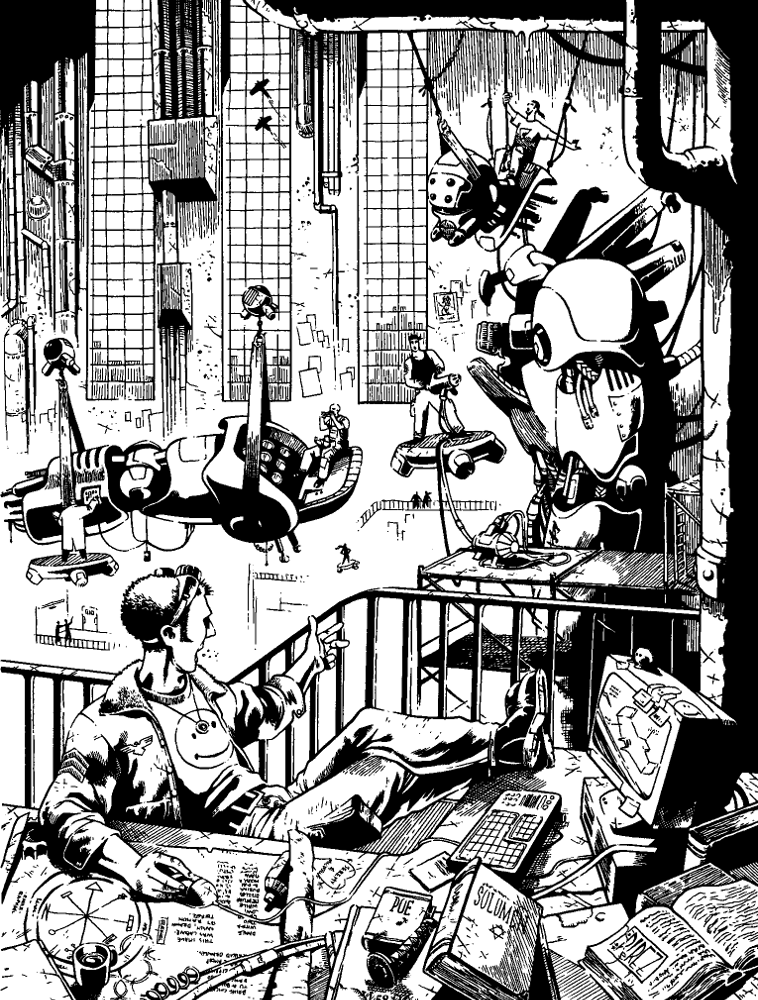
No joke, I just really like this picture.
Stormspire
Possibly the most advanced Techno-Wizard community, Stormspire is a huge but generally mercenary manufacturer of techno-wizard items. Despite having to hand-make all their times, supposedly they sell 30%+ of all Techno-Wizard goodies in North America! I guess they just forgot you can't really mass-manufacture those sorts of items - or if they can in some new fashion, it isn't mentioned. Technically they're part of the True Federation, but only due to Dunscon's intimidation. In any case, they largely just pay it lip service to Alistair's chagrin. The Coalition has attacked them, but they're able to teleport the area around the central tower of the city and rebuild in the ruins of Lexington. The Coalition forces were left isolated in the middle of Federation territory and suffered heavy losses on their way out with little to show for it. As a result, the Coalition is trying to find a way to disable the teleportation mechanism before making another assault.
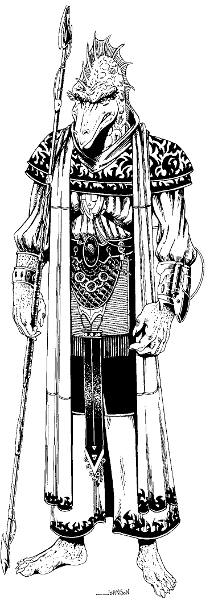
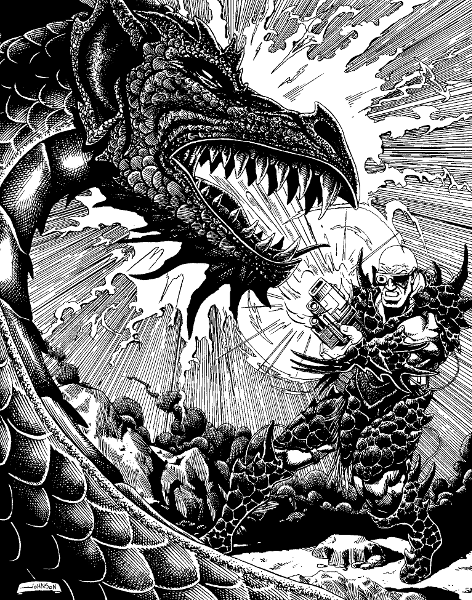
The Mr. Burns and Waylon Smithers of the setting.
Stormspire is ethically bankrupt, allowing slavery to an extent, allows the most mustachey villains to hang out, and has nothing in the way of scruples. It's run by...
- K'zaa: A Lizard Mage (ancient super-powerful wizard lizards from Conversion Book), K'zaa got bored with attempting to conquer other worlds and decided to become rich and powerful on Earth for the lulz of messing with other Earthly powers. Seriously, that's his characterization. However, he's kind of Hank Scorpio and rewards his employees justly.
- Dragonbane: A Dragon juicer who's K'zaa's number... one... guy. He likes killing dragons, killing dinosaurs, and asking K'zaa how high to jump.
Next: Siembieda and the no good, very bad magic system.
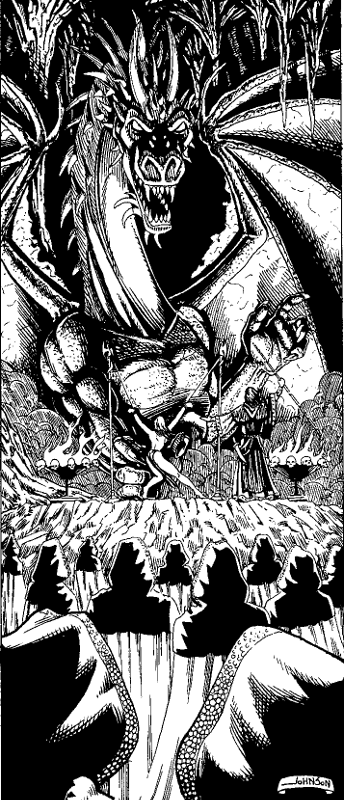
"Uh, is this consensual? Do I have to teach you about consent and human sacrifice?"
"Another one thumped his chest and snorted, 'That’s right, against the real powerhouse characters - Glitter Boy, ‘Borg, ‘Bot, Juicer, Crazy, Dragon, Power Armor - a mage is dead meat.'"
Original SA post
Rifts World Book 16: Federation of Magic, Part Six: "Another one thumped his chest and snorted, 'That’s right, against the real powerhouse characters - Glitter Boy, ‘Borg, ‘Bot, Juicer, Crazy, Dragon, Power Armor - a mage is dead meat.'"

Time to slow the review down a bit because we've got a infamous Siembieda Moment coming on. I'm going to counterrant a bit, and I don't mean to strawman this whole thing, but it's hard to avoid exploring the holes in this cheesy swiss chunk of an argument.
Playing Magic Characters
By Kevin Siembieda
So we start with a diatribe against people complaining that Rifts spellcasters are underpowered compared to other character types. He goes on about players pointing out that in straight-up combat, mages lose.
Rifts World Book 16: Federation of Magic, posted:
The limited range of spells and often costly expenditure of P.P.E. were the most frequently mentioned as “problematic.” Some of these players went so far as to suggest that a farm girl with a high - powered laser pulse rifle and telescopic sight could “blow away a wimpy Ley Line Walker from 2000 feet (610 m)!” Furthermore, they claimed, even if the sorcerer knew she was out there, shooting from the hayloft of her farm, he couldn’t touch her because the range of most (commonly available) magic couldn’t reach her.
Gosh, getting taken out by a girl. How awful!
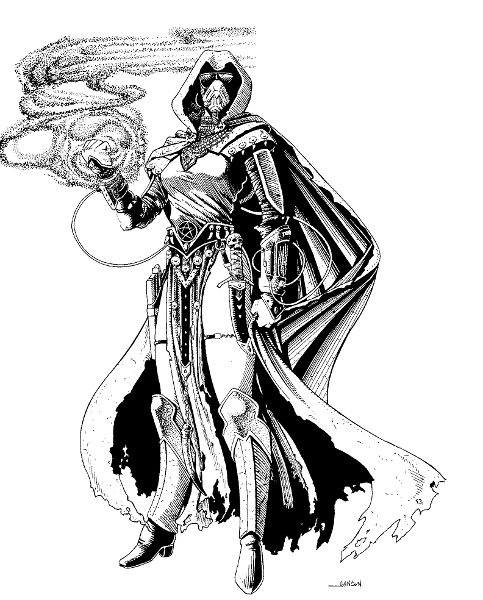
The magic of leaving your pants in the wash.
Rifts World Book 16: Federation of Magic posted:
s the game designer, the easy answer to such comments is simple: If you don’t like the magic characters/O.C.C.s, either don’t play them (which these guys didn’t) ... or modify them to your liking. This sentiment isn’t intended to he flippant or an oversimplification, but these are two valid approaches.
That'd be a fair assertion if magic was like, a small element of the game, but it eats up a lot of page space in many of these books. You're still likely paying for it. It should be fun, not like-it-or-lump-it. If people aren't happy with it, they aren't necessarily the ones to blame.
Rifts World Book 16: Federation of Magic posted:
1. “Role” playing can be much more than just shoot ‘em up combat
Kevin points out a wizard can use all sorts of movement, protective, or stealth spells to close the range with our farm sniper, which is true. But he says it's more interesting to find out why she'd be sniping at strangers in the first place than just shooting back mindlessly, and that the situation needs to be put in the context of a story. Which is a fair question, but it dodges the actual issue presented by his players rather than answering it.
And it's fair want to discourage combat, but Rifts really needs better and clearer mechanics to encourage that if that's what Siembieda wants to discourage. Skill rolls and charm/impress rolls are never clearly defined in the game. However, shooting people definitely is. Spells are- somewhat. Still, noncombat rules aren't robust, while missiles and guns get pages upon pages of detail, while a Lore roll is dependent on the goodwill and skill of the GM to interpret it fairly.
Rifts World Book 16: Federation of Magic posted:
2. Diversity is good
Not racial diversity, no, we're talking about diversity of characters, and Kevin points out that some people just get hung up on playing certain styles of characters, but that just because you don't like a character type doesn't mean others won't as well. Fair enough, but once again, these are character classes filling page space, and if a lot of people don't like some, you might want to look at that. This also ignores the number of characters in Rifts that have weak or nonexistent niches. Not many people will be crying out to have a Vagabond or Forger in the party. In addition, the number of wilderness or soldier classes is practically absurd at this point. A lot of Palladium classes are just slight variations on what came before, and some are just better than other ones.
Rifts World Book 16: Federation of Magic posted:
3. All things are not equal!
Ut-oh.
Rifts World Book 16: Federation of Magic posted:
Game balance does not mean absolute equality. All weapons, magic and characters should not have the same power level, damage, range, or application, even under the same circumstances. It's not realistic, logical, or fun.
Rifts World Book 16: Federation of Magic posted:
The real world is expansive and incredibly diverse.
Rifts World Book 16: Federation of Magic posted:
This same diversity should apply to role-playing games; at least on the design level, if not always in the playing. Diversity in an RPG adventure should expand the power, capabilities and options of the player characters as a group. Not just their combined “firepower” but a broad range of skills, knowledge and abilities that should help the group survive and adapt to most situations.
"Realism" and "logic" are bad pillars to place under your arguments in a game where dragons punch giant mecha. Both of them collapse under the square-cube law, and magic dances out the door. It's true each character should get different abilities to spotlight. The problem with bad balance is, by definition, that some characters never get the spotlight at all. If the mercenary with a laser rifle is plinking away for 4d6 damage while a Glitter Boy is dealing 3d6x10, that's not fun for the mercenary, and no amount of crying "realism!" will fix that.
Rifts World Book 16: Federation of Magic posted:
About players and playing. The unevenness of opportunities for characters (and their players through them) to shine and participate is most common in large groups of six or more, so players need to be understanding and accept this. Players should voice some concerns and discontent to the Game Master, but cut him or her some slack.
He emphasizes that it's the GM's role to make sure everybody gets an opportunity to be cool, but that some GMs will just suck. But:
Rifts World Book 16: Federation of Magic posted:
Don’t take things personally. If you, as a player, are the lone voice in the player group who wants more (or less) role-playing and less (or more) combat, don’t become a crybaby complainer, or rules lawyer to get even. Realize that the majority in the group do not want the same things that you want. If you cannot nicely get them to try other types of adventures, it’s okay. They aren’t jerks because they won’t change. That’s what they enjoy. Unfortunately, that leaves you with the dilemma of gritting your teeth and bearing it, or finding a different group of players. That’s valid. This is supposed to he fun, you know. If it’s not fun, something is wrong.
Rifts World Book 16: Federation of Magic posted:
Likewise, Game Masters should be concerned with the story, not pitting their cunning against the players, except in the context of furthering the adventure and making it fun and challenging to the players.
Good advice!... well, except for the pass-agginess about "crybabies" and "lawyers". The problem is that the whole specialization angle often falls apart in Palladium, either because you rolled badly at character generation or because somebody stomps all over your niche. If you play a Fire Warlock, a Phoenixi is going to show you up at every turn. No solution is presented for this. But we've gotten miles away from the original talk about wizards, haven't we? Well, let's get back to it.
Rifts World Book 16: Federation of Magic posted:
4. To say spell casters are “wimps” is crazy!
Rifts World Book 16: Federation of Magic posted:
Even if you measure “power” only by the brute strength and raw destructive “power” provided by M.D.C. body armor, power armor, bionics, missiles and big guns - even then - practitioners of magic are not wimps! Quite the opposite.
A fireball cast by a spellcaster of max level (15) will do 50% of the damage of a 1st level Glitter Boy, will have about 25% of the attacks of a Glitter Boy, have to spend more of their paltry attacks on defense (due to the mage often being less durable), and has 0.8% of the Glitter Boy's engagement range. (Yes, the GB can fire 122x farther.) In addition, the spellcaster will have a far slimmer amount of "ammo" to use. So this is demonstrably and hilariously false.
However, Kevin is impressed that a wizard doesn't need any external gimmicks to do their craft, the equivalent of being impressed with D&D monks despite their paltry combat abilities because "you can't ever disarm them!" Well, unless you make a habit of disarming PCs, it doesn't matter a whole lot.
Rifts World Book 16: Federation of Magic posted:
High level characters can become the equivalent of demigods!
I presume he means proverbial demigods, because the Demigod R.C.C. can effectively take multiple spellcasting classes at once and outshine most vanilla human and D-Bee spellcasters. So it's a bad turn of phrase. But... I guess balance doesn't matter. A better point that he makes is that there are a wide variety of utility spells you can use to fulfill a variety of roles, which is true. Just, you know, don't expect to be a damage-dealer or taker. However, some are more or less useful. And that's where, much like D&D, spellcasters are best at finding tricks that give them overall utility, and that's where Rifts sorcerers do work. However...
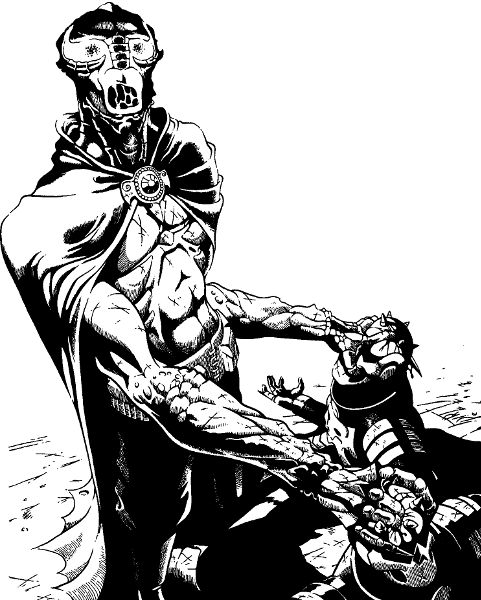
"Hugs for your face!"
Rifts World Book 16: Federation of Magic posted:
More Spells & New O.C.C.s
... he then potentially undermines his whole argument by adding they've created new mages and spells for this book that are
Rifts World Book 16: Federation of Magic posted:
Consequently, many of these new incantations are clearly intended to address, equal or counter high-tech weapons and machine, as well as deal with armed forces and the proliferation of magic

But technological characters will still get around twice to quintuple the action economy there, and they still get saving throws.
In any case, after all of the talk how to be better be a better wizard player and like or lump it shrugs, he could have just written, "if you don't like the existing spellcaster classes, take a look at the new ones, maybe you'll find something you like!" instead of a long passive-aggressive diatribe about how maybe the problem is on your side. Because that's what this section comes down to, instead of looking at wizard combat and realizing that they're beyond crippled in many conflicts, he shrugs and lays all the work in fixing that at the player's feet.
TL;DR: get gud, wizzards
Next: I'm a fuckin' wizard.
"Like legendary Oriental mystic warriors, the Battle Magi learn focus, concentration and mastery of body, mind and magic."
Original SA post
Rifts World Book 16, Federation of Magic: Part Seven: "Like legendary Oriental mystic warriors, the Battle Magi learn focus, concentration and mastery of body, mind and magic."
Suddenly, Dungeons & Dragons tropes attack! We get a note that practioners of magic-
Rifts World Book 16: Federation of Magic posted:
Remember, that “practitioners of magic” (Conjurers, Ley Line Walkers, Shifters, Magi, etc.) CANNOT be covered in metal and most types of “full” M.D.C. body armor because it interferes with the flow and channeling of magic energy.
Wait, what the fuck? This has never been mentioned before. Weren't we just talking about how wizards have a hard time already in the last chapter? I mean, yeah, sure, there are other forms of body armor, but they tend to be more expensive and difficult to repair. In addition, spellcasters in older books just got normal body armor and it was never a big deal. Well, now it is. Seriously, why is this a thing, other than "well, D&D done it"? It's not like wearing normal armor is something that makes you more potent than the average character - it's a basic requirement of the game! Not being able to replace and repair it normally is a huge drawback!

Okay. I'm okay. This is okay. Let's move on to the classes.
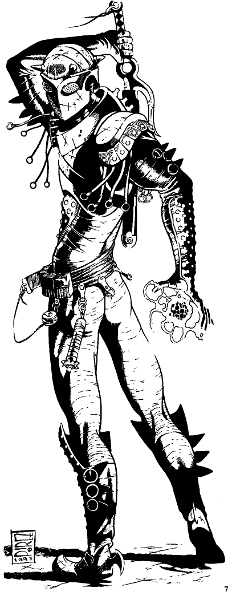
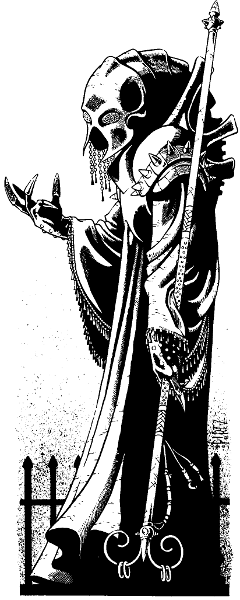
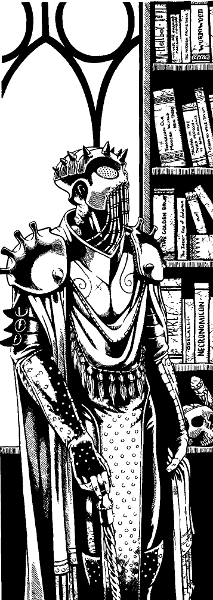
The Buttle Magus, Bird Magus, and the Bugeye Magus.
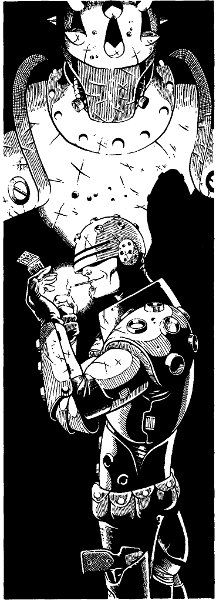
"Alright, let's break this system down."
Magus O.C.C.
So, this covers spellcaster who are taught special secrets by the Lords of Magic. And they're notably more powerful than the core spellcasters. Their main drawback is that, like most spellcasters that aren't the Ley Line Walker, they can't add spells greater than 4th level or their current level to their repitoire (whichever is higher)... with one notable exception that'll be coming later. To be fair, they're at least conceptually and get some neat Perez art, but the actual execution has issues. Once again, the % listed in your chance of qualifying for the class as a human character.
- Battle Magus O.C.C. (3%): A jedi wizard that gets a farcical number of combat bonuses, as well as quick-draw / sharpshooting / dual-wielding (including for spells, even though that generally doesn't actually work because they're usually not aimed) like a gunfighter. Can pilot automatons, which are magic mecha we'll be seeing later. But they have restricted access to spells, mostly just getting combat casting. They get a full suit of armor that doesn't restrict spellcasting because it isn't "environmental". Didn't know that was a limitation that wizards had as well, but okay.
- Controller O.C.C. (6%): A variant on the Battle Magus that trades the gunslinger-styled abilities for a wide variety of bonuses when controlling automatons, including controlling multiple automatons at once. For those interested in busting down the action economy, this is a good start. Of course, good luck obtaining and maintaining the 5+ automatons you can control at once, but I'm sure you'll find a way as an enterprising murderhobo. Hell, you do end up getting 4 free ones by level 5-6 if you're working for Dweomer, after all, including the likely possibility of getting a friggin' 1600 M.D.C. Kilairgh Automaton (in addition to the other ones!). Ridiculously not well thought-out, combine this with a powerful race that can take an O.C.C. and go to fuckin' town on the game. Glad we already decided balance isn't important and characters don't need to be equal.

- Lord Magus O.C.C. (1%): Special meditation techniques let them channel magic to become a "creature of magic" and become an M.D.C. creature, and they specialize in low-to-mid level spells, and can't cast anything above 10th level. Not much else to add, especially given that so few characters are going to qualify for this class that it may as well not exist.
- High Magus O.C.C. (5%): So, this is supposed to be an enchanter and crafter, and works in the creation of magic items, and are supposed to be nice and sensitive and creative... because. (Now if we only had rules or even guidelines for magical item creation!) Because they're "attuned to magic" they get a lesser version of the Battle Magus' combat bonuses. They can also assist with creating automatons and can "bond" them to new users. In addition, they get stacks of bonuses and get a special ability every level, with the big defining one being able to turn invisible at will from first level. They're supposed to be leader sorts, but there's nothing really in their skill or ability sets that gives them any particular facility with leadership. The particularly bizarre thing is though they get a huge laundry list of lower-level spells, other than those fixed picks they can only ever learn spells above 7th level, and automatically clear all spells of spell levels 11-15 by class level 5. Unlike other fantasy games, though, this is actually heavily restrictive because of the high power and action cost of those spells - they can do a lot of big ritual stuff but don't get nearly as much practical magic.
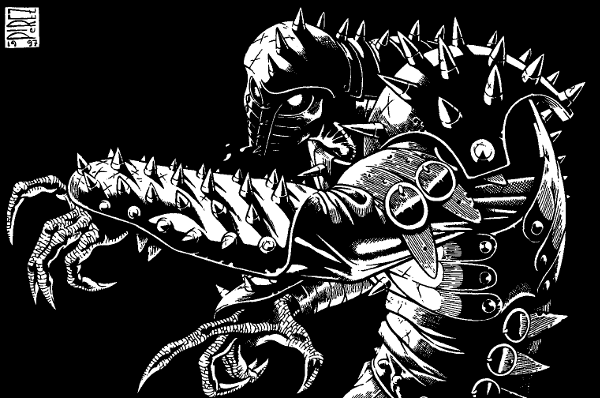
"Once you ssstrap in you don't ssstrap out."
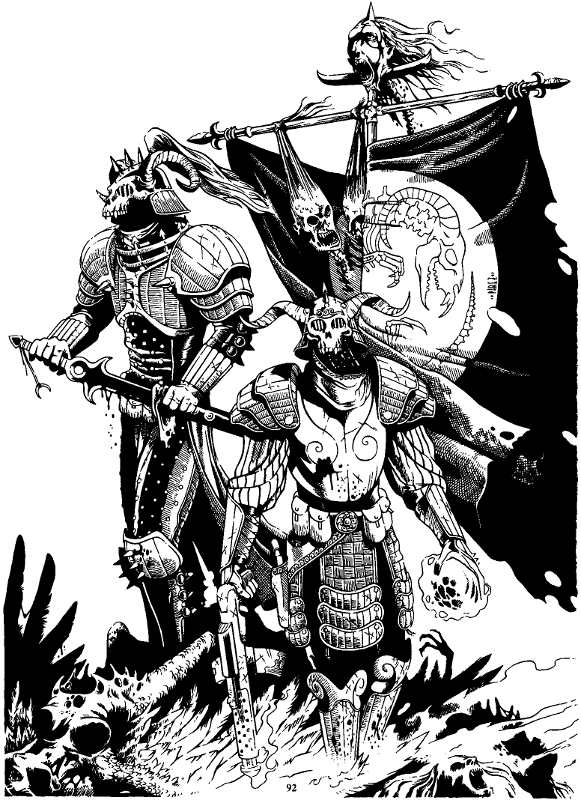
KaelCon, for very specific fans of Lucas' greatest masterpiece.
Next, let's move on to some eeevil classes that personify the True Federation of Magic.
- The Corrupt O.C.C. (100%): Want to sell your soul and you don't particularly care who? Why, pledge your soul to be mysterious "Liberator" who gives you power in exchange for going around making people afraid, sad, and dead. Side effects include a sudden lust for leather, spikes, and spooky armor. Become a scary mega-damage monster with claws and super-strength, as well as a few powers based around sneaking around. If you're really strong willed, you can look normal most of the time (save for dressing entirely in belts) but only go Buffy-style vampface when you unleash your powers. If you want to go full doomed manchild, you can play one of these as a good guy but all your bonuses get sliced in half and you're really more of a dark gimp than a dark lord at that point. My advice is: don't!
- Mystic Knight O.C.C. (9%): The evil dark magic answer to Cyber-Knight, complete with a code of dishonor that expouses ruthlessness and loyalty. How to become one?
 But they're supposedly bad dudes. They can channel magical energy to power items, shoot blasts, and ignore non-magical energy attacks. They get some ley line powers, modest combat bonuses, and low level magic and psionics. That, and a skull mask, apparently. Basically just dark jedis minus lightsabers.
But they're supposedly bad dudes. They can channel magical energy to power items, shoot blasts, and ignore non-magical energy attacks. They get some ley line powers, modest combat bonuses, and low level magic and psionics. That, and a skull mask, apparently. Basically just dark jedis minus lightsabers.
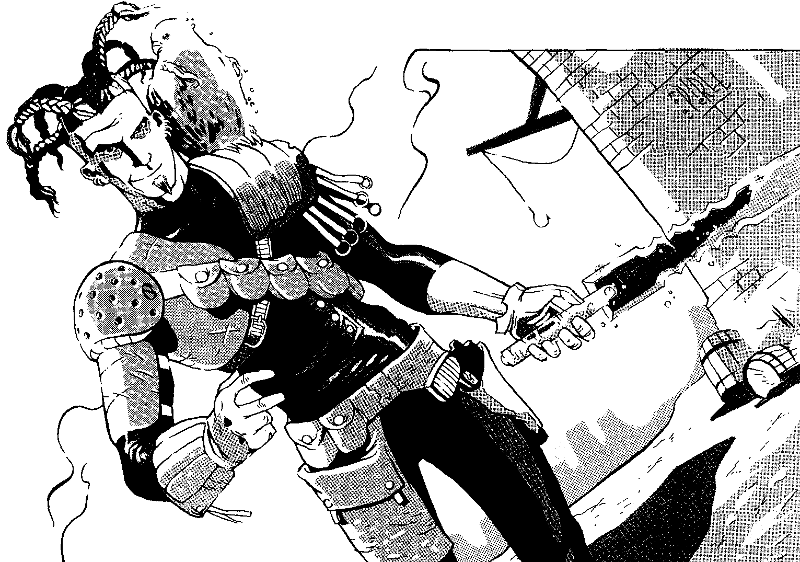
Would you let this man in your party?
Lastly, we get some miscellaneous magic folks:
- Conjurer O.C.C. (9%):
Rifts World Book 16: Federation of Magic posted:
“Some folks say we ain't nothing but a pack of T-Man wannabes. But let me ask you this: Who’s more likely to catch ya with yer pants down? A beefed up, hay-naked tattooed freak, or a kindly old man who ya met walking dawn the road?"
- Hawkfire the Hidden
Maybe you'd have better chances at catching people with your pants down if you didn't brag about it, Hawkfire. These are gimmick spellcasters created by Doug Coughler and coopted by Siembieda, and who specialize in their namesake. They can create items and animals temporarily, but most of them are non-technological and S.D.C., rendering it pretty much useful for tricks and not most of confrontations. You can make some M.D.C. objects, but only at high expenditures. Making permanent stuff has permanent costs. There's also a laundry list of limitations to keep you from dropping whales onto villains or poofing snakes into their pants, so the fun police ride high here... though you can still probably find some wiggle room to argue with the GM when you try to summon a bear in the Coalition Officers' outhouse. Otherwise, they get some very basic spells and are generally really, really shitty spellcasters outside of conjuring, so unless you like their smirky trickster gimmick, you can give them a pass.
- The Grey Seer O.C.C. (38%): These are independent, neutral, pacifist mystics who try to aid people with their precognitive gifts. They're universally opposed to the True Federation, seeing Alistair a possible "5th Horseman" that endangers the world (from a prophecy wayyy back in Rifts Sourcebook 2: the Mechanoids). As a class, they're basically just variants on the corebook Mystic O.C.C., trading some of its psychic powers for the ability to sense death or life, whether or not somebody causes death or protects life, and a completely GM fiat precognition ability. Will it be useful? Ask your GM!

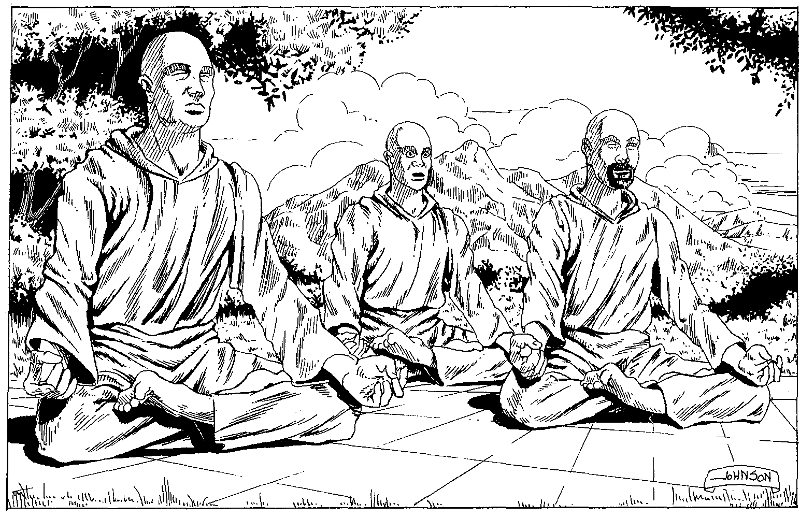
Insert your own caption!
And that's our class stack for the book. Overall, it's a power-up for spellcasters, particularly that ridiculous Controller O.C.C., though the Ley Line Walker still has role protection in that they're the only ones able to completely ignore their class level when selecting spells. Mind, this is all assuming your GM lets you cheat on your attribute rolls, as you're unlikely to qualify for most of these classes if you're playing by the book.
Next: Magitek armor.
"Pilots other than Controllers and the Lords of Magic must be in physical contact (seated in the damn thing) to control/pilot it."
Original SA post
Rifts World Book 16, Federation of Magic: Part Eight: "Pilots other than Controllers and the Lords of Magic must be in physical contact (seated in the damn thing) to control/pilot it."
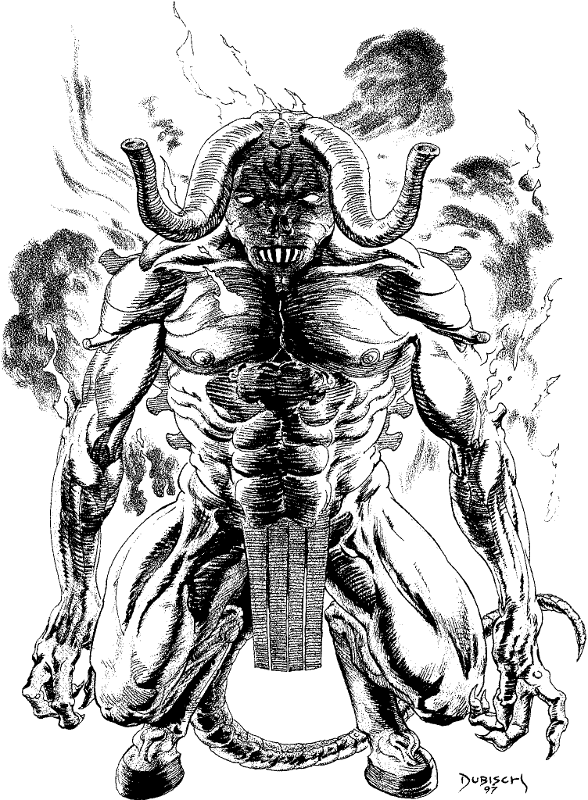
"Did you have to give the war machine nipples?" "Look, the fireballs gotta come from somewhere."
Magic Automatons
By Kevin Siembieda and Peter Murphy
So, these are the special golems built exclusviely by Dweomer that controllers and the other "magi" classes can run. They have to meditate for 24 hours of attunement and a nominal cost. However, these hyper-advanced mages still struggle with sophisticated "roof" or "cockpit" technology. Instead, mages are expected to ride on top where missiles and bombs can be conveniently deposited, going BYOA (Bring Your Own Armor). Controllers can remotely run them up to 200 feet away, which means they can use the better tactics to hide via camouflage or invisibility spells and remotely run their automaton.s Most magi can only run one at a time; as aforementioned, controllers can run more than one. It's said the Lords of Magic can run a hundred at a time, which is the sort of combat ability that causes the Palladium combat system to immediately collapse into failure hole too deep for the bottom to ever be seen. Only controllers and the LoM can multitask while running an automaton, though; otherwise you have to use your attacks normally to run one. Which... is a problem, because unlike normal power armor and robot vehicles, there aren't combat styles or bonus attacks for running one, which means that in terms attacks per turn and combat bonuses, they're notably weaker if they're not being run by controllers.
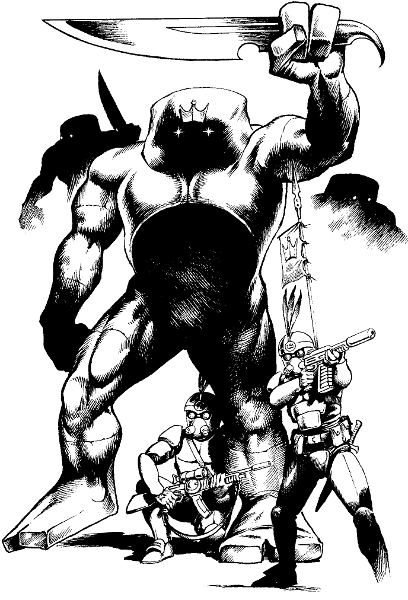
The Earth Thunder gets a neat design, at least.
Most of the automatons have a common issue to high-scale supernatural combatants in Rifts: high M.D.C., low damage, so any combat with them is going to be sloggy. Some have the ability to cast magic spells, which is usually of limited utility save in the few corner cases where a given spell breaks vehicular combat. Most of the defensive spells, for example, are slow to cast and situational, and generally they won't stop a sufficient quantity of mini-missiles. They can also be put into a regeneration mode that lets them recover, but due to badly stated rules, can't regenerate unless they're under 100 M.D.C. (it's probably intended for them to regenerate 100 at a time, mind). If their pilot is knocked out, they're programmed to grab them and high-tail it to a pre-designated safe zone (usually not Dweomer itself, as to not just lead enemies there). Controllers can see through them at a distance, but only the top-level ones have magical loudspeakers for their pilots.
Rifts World book 16: Federation of Magic posted:
Automatons are magical, golem-like constructions designed to take on dragons, demon hordes, tanks, robots, power armor, ‘Borgs, and entire armies. These powerful magic robots can go head-to-head with anything the Coalition can throw at them.
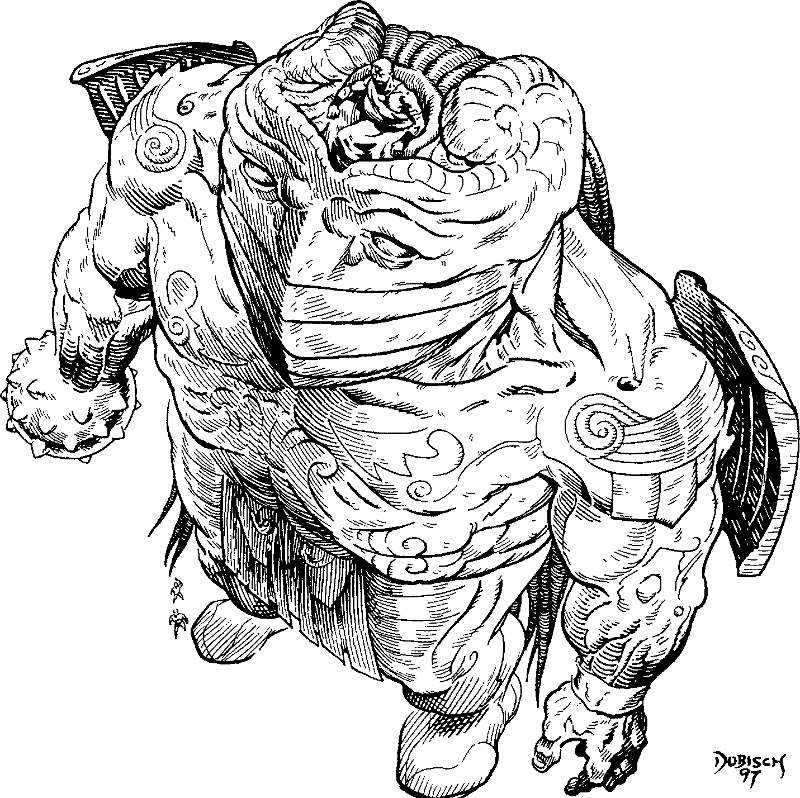
"Love this Colossus, glad nobody's found a way to shoot things from above!"
We have seven flavors of automaton, and since the gauntlet has been thrown down, I'm gonna put them in rumbles and the skulliest and fascistiest of the Coalition.
- Battlelord Automaton (1000 M.D.C.): Swings a big sword that can shoot lightning or fire eyebeams. Versus Coalition: It's modestly damaging, but its defensive over offense measure means missiles and rail gun blasts will likely tear it apart; SAMAS power armors can dance out of the range of its damaging melee attacks and strafe it into rubble. Coalition 1, Dweomer 0.
- Colossus Automaton (2000 M.D.C.): Though its iron mace does a ton of damage for an automaton, its eyeblasts only do passable damage. Its big effect is to be able to cause stompy shockwaves that can effectively stunlock infantry and many human-scale landbound creatures, leaving them stuck on their ass. In addition, its ability to cast disharmonize, firequake, or collapse will make the going impossible for most groundpounders. Lastly, it can cast annihilate once or twice a fight to just do 700 M.D.C. with magical antimatter, or 100+ on a miss. And all of that seems pretty badass until you remember only high magi can pilot this, which means they have to sit in the missile impact zone as the skullfaces drop high ordinance on his head from miles away. Whups. Gonna call this one early, score is now Coalition 2, Dweomer 0.
- Earth Thunder Automaton (500 M.D.C.): It's a smaller one with a hooked sword that is an "anti-dragon" weapon that acts like a "can opener". Damage? 25 M.D.C. That's 10+ successful hits just to take down a suit of power armor, just less the 50-100 hits you'd need to kill a dragon. It has some short-range spells, so all the Coalition has to do is set up a fire zone and have one side withdraw if it starts getting close. Laser rifles and rail guns can take this thing apart at range pretty easily without even bringing missiles and artillery to bear. Coalition 3, Dweomer 0.
- Fire Demon Automaton (500 M.D.C.): A big flaming minotaur statue, and we're told that "few things can stand before its brutal fire attacks". However, given its fire attacks do between 1d4 and 6d6 mega-damage, even a suit of dinky Plastic-Man armor holds up to that for at least a single shot. Even though it has a ton of redundant fire spells, once again the Coalition can just set a line of laser rifle guys and gun it down. Coalition 4, Dweomer 0.
- Ice Drake Automaton (300 M.D.C.): A flying drake that radiates cold, its ability to coat targets with blinding frost and ability to outspeed a SAMAS means it could actually catch up to flying power armor and keep it blinded while raining down magical attacks. Pretty cool! Unfortunately, the Coalition also has sky cycles and jet fighters that can dogfight circles around this thing and missile it out of the sky. Coalition 5, Dweomer 0.
- Kilairgh Automaton (1600 M.D.C.): Named after supernatural predator not appearing in this game, this is basically a big bugbot with pincers. This is the top of the wizard game, folks: pincers. To be fair, it has some nasty spells, like the damage-reflecting house of glass, but its limited range puts it in the same camp as the Colossus. It's more or less the diet colossus, with an even more limited arsenal. I don't even need to get into the details: Coalition 6, Dweomer 0.
- Infiltrator Automaton (220 M.D.C.): A human-sized automation made out of magic glass that can pass through walls and gets a variety of sneaky spells. As such, it requires a controller to tag along after it. Its success pretty much depends on the response times of dog boys and psi-stalkers to a supernatural assassin, but given this thing can run 50 MPH, I'm gonna say it can ghost into a Coalition compound, murder some high-ranking officials in their skivvies, and get out unless they happen to have psycho-stalkers who can both sense and react to it fast enough (and very few units will, given there about fifty of the guys in the world). Dweomer picks up a point in the final stretch. Coalition 6, Dweomer 1.
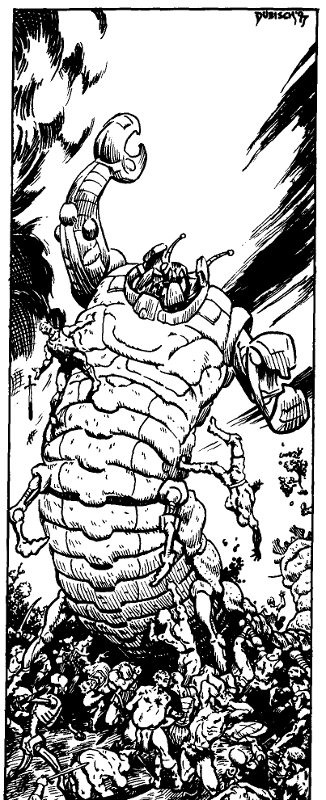
"Kill!" "ARGH!" "Hey, that's a good name."
It's kind of weird to think that these things are a match for any modern mechanized armor. It's like saying "Yeah, we don't have artillery... very little recon, very little air support... but we have really big swords!" It's like they expect the Coalition to act like a scene from the Starship Troopers film, just shouting and running into melee in a parody of a '50s war movie. But the very mechanics of Palladium combat, with their farcical ranges, speeds, and the high durability of automatons... all discourage that. Granted, automatons can be notably stronger with a very experienced wizard at the helm. But they also do a lot to actually reduce a wizard's strengths. In Palladium, spellcasters are pretty bad at straightforward damage exchanges, but excel at dirty tricks. By putting them atop a giant fighting statue, they become spell turrets at best and half-assed robot pilots at worst. Though automatons shield them from ground-level forces, a Coalition soldier with a good throwing arm and a satchel charge can take one out, which one would think would be a key problem. C'mon, Dweomer, at least give them an armor of ithan spell! Yeesh.
Next: Magic bullets.
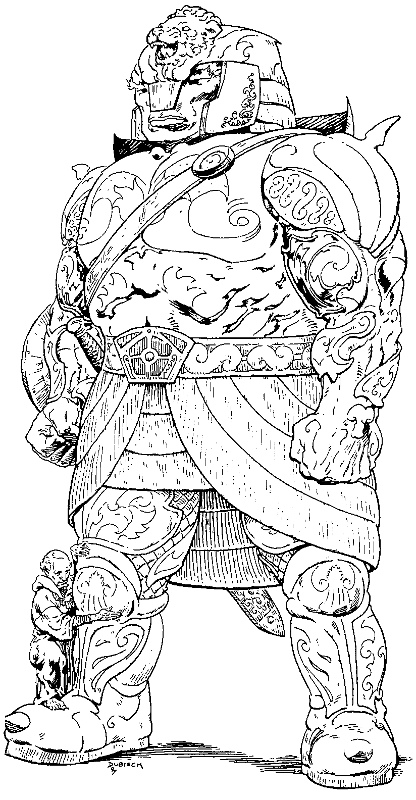
"Hugs!"
"Each weapon is hand-crafted, so while they may do the same thing, no two look exactly alike."
Original SA post
Rifts World Book 16, Part Nine: "Each weapon is hand-crafted, so while they may do the same thing, no two look exactly alike."
Techno-Wizard Devices
Or "mostly just guns", because that's technology in Rifts for you. They're extremely expensive because... they are! I know, I know, you'd think it'd be more complicated to develop batteries, electronics, an armory, lens, and everything else you'd need for a high-powered laser than something that runs off of crystals and magic scratches, but what do I know? Well, what I do know is that this section references a "usual penalty of -6" for firing a weapon with burst fire (even for recoilless weapons... because... ?) that is not the usual penalty but will become the usual penalty in later books. They've also developed TW special energy cells used by some weapons, because we definitely need more arbitrary ammo types added to the setting. Also, we get a reminder that they're "hand-crafted", maintaining my puzzlement as to how Stormspire mass-manufactures techno-wizard weapons.

TW Pistols are fairly unexceptional whether they fire lightning, ice shards, or fireballs. Though a 4d6 TW Firebolt Pistol is solid for a pistol, it remains the fact that the low damage of pistols makes them niche holdout weapons for the most part. Only the TW Jammer stands out - but it's basically just a casting device for negate mechanics, which can knock out a gun or a explosive from going off for 15 seconds, or shut down one system on a suit of power armor. Actually kind of a handy given it's an end-run around normal casting times. Remember the murderhobo buddy system: one negates while the other liquidates.
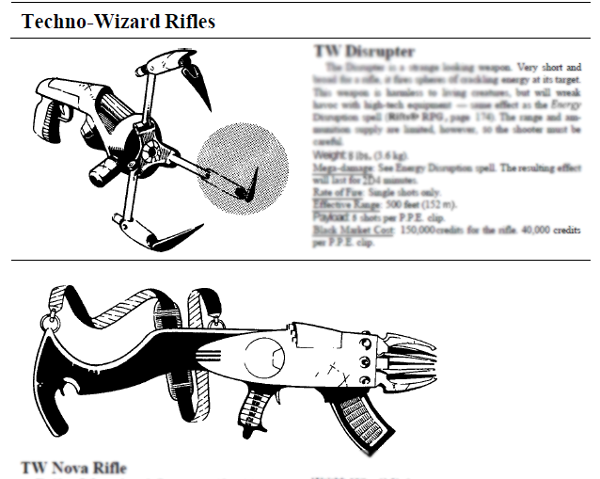


TW Rifles are a bit more interesting, and some, like the nova rifle or force cannon, actually do decent damage. The storm rifle is one-half boring lightning gun and one-half boring air blower. The sonic rifle has an impressive area knockdown effect, but forgets to specify how much damage it does. The disrupter casts a spell (energy disruption) that doesn't actually exist in the book. Well, that's our Palladium!
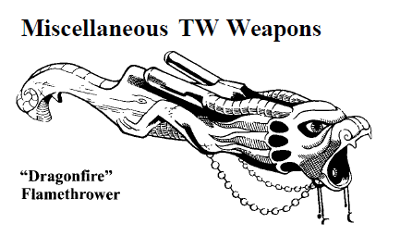
Miscellaneous TW Weapons include a fairly damaging "Dragonfire" Flamethrower, grenades that create blocks of ice or explode in flames, and landmine that shoots lightning for a minute to the nearest living creatures or metal objects. Then, we get into stuff that feels more typically "magic item-ey" - a whip of pain that casts agony, a scepter of command that compels the undead (mostly), a firestaff that shoots fire spells, etc., etc.
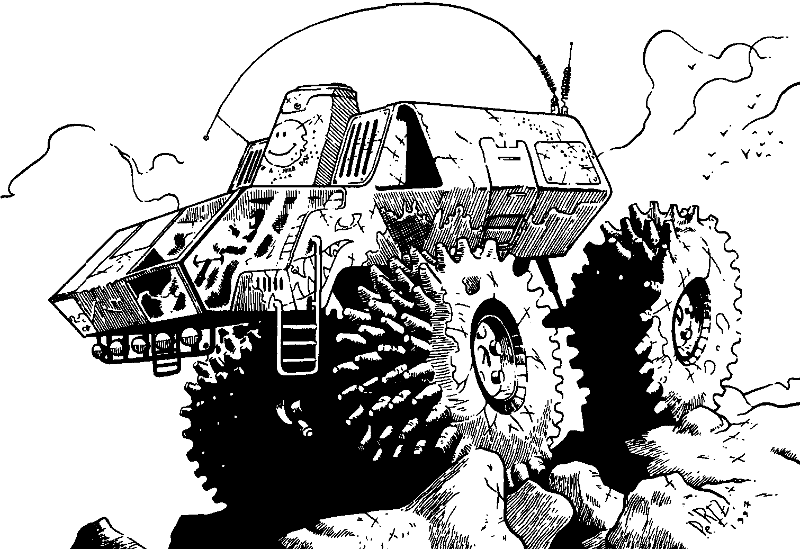
Just don't ask how to get in.
Techno-Wizard Vehicles are mainly designed to travel along or recharge when on ley lines, and are farcically expensive. It's implied there are more affordable models, but fuck 'em, only the %1 of the post-apocalypse need apply.
- The TW Battle Skimmer (1280 M.D.C., 8+ million credits) is a flying Jabba barge that looks like a manta ray, and is mostly just a floating platform with some "starfire pulse cannons" on mounts that gunners can fire. It can only move along ley lines and has no bells or whistles; we're told it's a "potent war machine" even though it seems to have a completely exposed underbelly.
- The TW Ley Streaker (220 M.D.C., 5+ million credits) doesn't involve nudity, but you could probably fly it naked if you really like. This is a high-speed ley line flyer, going 600 MPH. There's a combat version that throws on a passable lightning cannon, crappy lasers, and some mini-missiles.
- The TW Zone Ranger ATV (350 M.D.C., $1.5+ million credits) seems like it would be designed as a PC hauler if it wasn't so expensive, with various add-on features like driving on water like a Jesus truck, chameleoning when still, flying at slow speed for an hour (very random, but okay, get your chitty chitty bang bang on), shooting fireballs from its grill, shooting lightning from the bumper, or a starfire pulse cannon. We're also told stuff like radar and a radio may be added "at the owner's expense", and be prepaired to make up your own ledger, because there are no prices listed for those.
- The Trailblazer Assault ATV (475 M.D.C., 7+ million credits) is more of a straightforward all-terrain attack vehicle, with a starfire pulse cannon (okay, okay, I'll mention they do solid damage and fire blue-white generic magic sparkles, fiiine), mini-missiles, a special force field (but no weapons can be used), and a full sensor suite. It can also have any of the add-ons on the Zone Ranger ATV, in case it doesn't cost enough money for you.
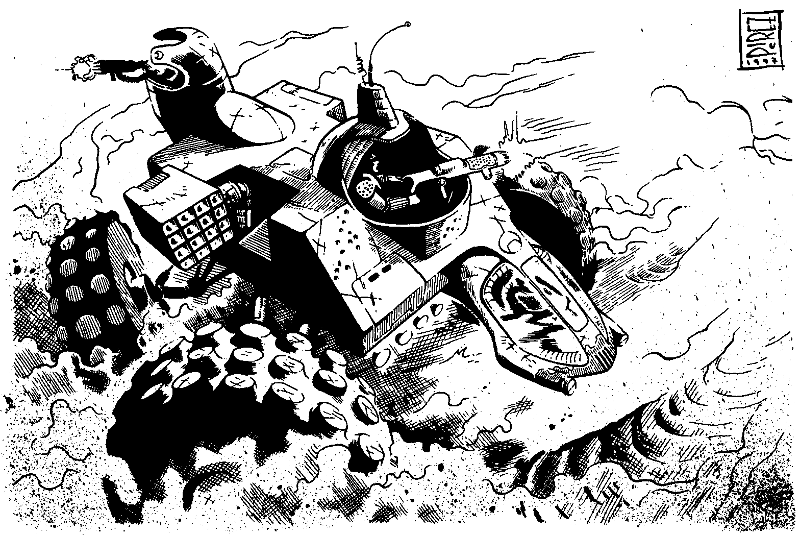
Even sorcerers love to go muddin'.
Next: The biotruths of magic.
"Marked by death, whenever ghouls are encountered they point, lick their lips and giggle; banshees weep bitterly; vampires find him unworthy of eternal unlife; and those who can see auras can actually see the black, negative energy of the curse and know he is a murderer."
Original SA post
Rifts World Book 16, Part Eleven: "Marked by death, whenever ghouls are encountered they point, lick their lips and giggle; banshees weep bitterly; vampires find him unworthy of eternal unlife; and those who can see auras can actually see the black, negative energy of the curse and know he is a murderer."
New Spells
By Peter Murphy & Kevin Siembieda
additional text and ideas by Patrick Nowak
There are over 125 new spells here, so I'm going to restrict myself to a top ten spells of note in Federation of Magic. Not much else to add, it notes that elemental spells in this second can be used by Warlocks, but those aren't tagged or anything, of course. Your local GM is a far more reliable resource of proper answers than Big Palladium. Rely on locally sourced, sustainable house rules.
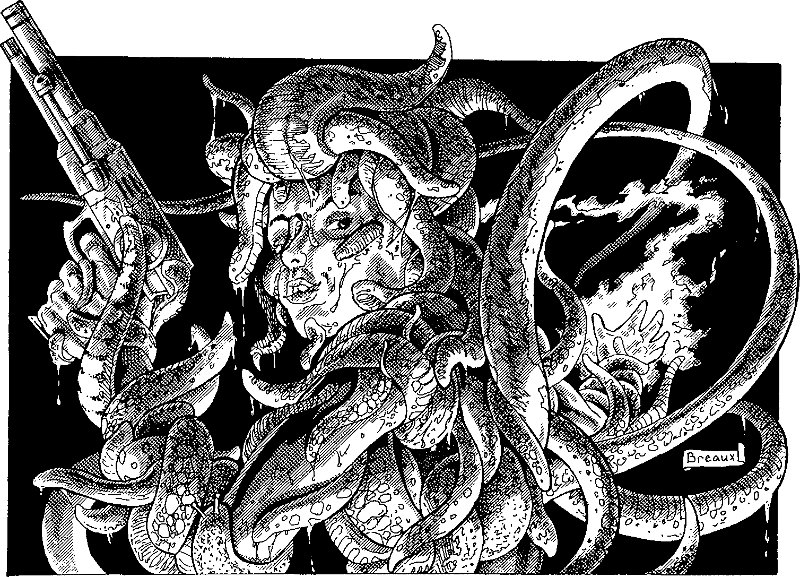
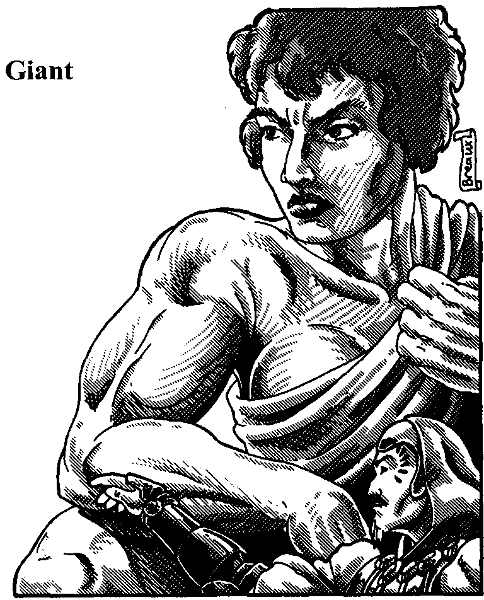
"I only cast it for the protection, I swear it's not a fetish thing."
- Life Source (3rd Level Spell): Lets you use up two S.D.C. or H.P. for one P.P.E., which opens up the side build of finding some D-Bee race with inflated S.D.C. totals (cross-to become a mega-mage by throwing your sweat and blood at spells, but has the rider that it prevents regeneration and magical healing. What happens when an M.D.C. creature uses this spell? Well, it's a mystery.
- Deflect (4th Level Spell): A commonly cited defensive spell that lets you parry ranged attacks, even missile volleys. However, you have to roll a unmodified d20 when you reflect a high-damage attack (i.e. 1d4 x 10 or more mega-damage), and on a 1-4 it hits an ally, and on 5-8, it hits an innocent bystander. However, even if you succeed at this roll, it's suggested that a bystander be hurt if there's enough people are around anyway. Man, my group sure is glad I played a wizard, what with me bouncing 1 in 5 successful rail gun parries into their jimmies or jammies. Wizards are awesome!
- Armor Bizarre (5th Level Spell): This creates a modest suit of mega-damage armor made out of tentacles, but its real strength is in forcing anybody fighting you to make a Horror Factor save against the armor's Horror Factor every melee round, resulting in a good chunk of extra rolling and a chance that even the hardiest of foes will for some reason be like "gross, tentacles!" even though they live in a world where evil tentacles are, you know. Sundays.
- Death Curse (5th Level Spell): A curse you can cast upon death (that then prevents most resurrection attempts, so no doing this and then coming back) that basically wrecks the cursed character with numerous penalties, and the only wan to remove it is to get a god's cooperation, and even a god only gets a 21% to revoke it. The only way to remove it is to "make amends for the death" but we're told this is "always herculean and often impossible". Does this sound mostly like a way to punish PCs arbitrarily for killing a GM's favorite GMPC? Sure does! Sure, you could have a plot with a doomed NPC, but let's not kid oursleves; the smugness this of this spell isn't intended as anything other han a handslap for players.
- House of Glass (5th Level Spell): This turns the target into "magic glass" that takes any damage they inflict on the caster for the duration. Of course, the caster can attack them without reprisal, because. Pretty busted in the right circumstances.
- Implosion Neutralizer (5th Level Spell): This lets you make missiles or explosives and force them to implode harmlessly rather than explode. Kind of thing mages need in this setting, really, though so many robots have so many missiles this can be academic. "Okay, you have 48 missiles, I can cancel a number equal to my level... ah-ha! You only have 41 left now!" You can try and target a missile in flight if you can beat the missiles initiative with your own initiative. Wait, do missiles roll for initiative? Well, they do not. Guess you win?
- Ballistic Fire (7th Level Spell): Oh, here's a great example of how bad combat spells can be. This is "an anti - infantry spell designed to mow down large numbers all at once". Thankfully, it automatically hits, but it lets you fire... one 1d6 missile per level. That means, at 7th level, if you concentrate all your fire, you might be able to take down a single infantry target wearing mega-damage armor... rarely? If they're Coalition, definitely not, given their new inflated armor values. Whups. Also, since it's a 7th level spell, it takes a full round to cast! Or you could fire off a 4d6 or 6d6 rifle four to six times a turn. "Anti-infantry", more like... anti-effective... try.
- Negate Mechanics (7th Level Spell): This nulls a technological item like a gun or grenade, preventing it from working for 15 seconds. As mentioned earlier, since there's no save, you can just continuously null somebody's gun while a buddy goes to town on them. Against power armor, vehicles, cyborgs, etc., you can only negate a single system and explicitly can't turn off a cyborg's body parts / organs, so no glitching pacemakers.
- Sorcerous Fury (8th Level Spell): One of the good combat spells!... it still takes a full round to get started, but after that you can hover around shooting 2d4 x 10 mega-damage bolts at your normal attack rate. That's pretty okay! You also get a bunch of combat bonuses as well. But it keeps you from using tactics and might lash out at anybody in your way and it exhausts you in the end and makes you feel sad and bad. Also you may have murdered a baby in a pushcart. But at least you could actually participate in a fight, so there's that. Sorry, pushcart baby.
- Beat Insurmountable Odds (9th Level Spell): This is a weird one where you're supposed to be able to basically become a bit more competent and / or lucky and it's... complicated. You can do like modestly superhuman stuff (if you can jump 10 feet, you might be able to jump 13 feet or somesuch, definitely worth 70 Potential Psychic Energy points to jump a little farther)... 65% of the time when under this spell. Or it might give you +4 to an attack, or 50% bonus range, or do something that's "one in a million" 30% of the time, or get +40% bonus to avoid death when you're badly injured. It's a weird mashup of vague and specific and confusing. At one point it says you get +4 to half your attacks in a round and another it says you get a bonus of +1... really, just, try and read this spell if you have the book and parse what it does. I dare you. I double dog dare you.
- Deathword (10th Level Spell): This basically lets you kill any human-tier character around your level by doing damage directly to hit points, bypassing armor and their S.D.C. It isn't as effective on mega-damage creatures, but a failed save versus magic means they have to make the special save versus coma or get kayoed for 1d4 hours where they seem dead, and then have to make a save versus death to come out of that coma! One of the few times taking a full round to cast a combat spell might be worth it.
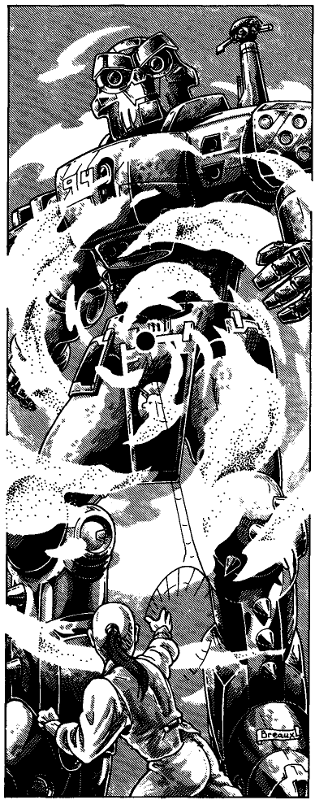
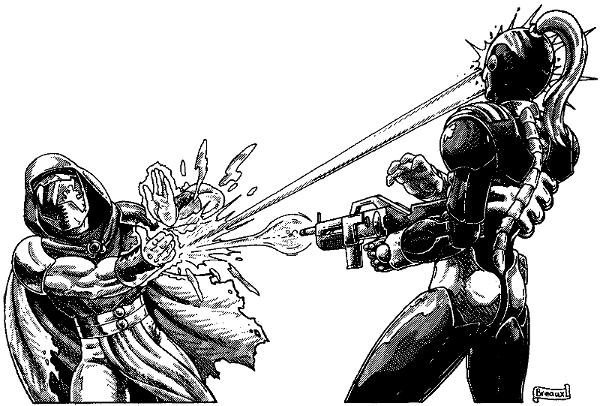
"Catch!"
And though a lot of
 are put over to high-level spells, once we get past 10th level we get into "too impractical in many situations to bother casting" territory, on account of the time and casting cost. Other honorable mentions in new spells include Summon & Control Sea Serpents, which lets you summon and control a monster only detailed in a different Palladium game, Giant, which lets you turn somebody into a giant (side trick: turn an armored foe into a giant, shattering their armor, since there's no save, then immediately cancel the spell, leaving their ass in the wind), or various healing spells (while generally overcosted, healing is now a thing wizards can do). There are some legit cool gimmicky things wizards can do, but it's indicative of the wishy-washiness with wizards - some spells are really, massively effective, while others have enough catches that you feel like you're reading a EULA every time you cast a spell. And with their action economy being crippled, they have no choice but to zero in on the most effective, most game-busting spells if they want to have fun.
are put over to high-level spells, once we get past 10th level we get into "too impractical in many situations to bother casting" territory, on account of the time and casting cost. Other honorable mentions in new spells include Summon & Control Sea Serpents, which lets you summon and control a monster only detailed in a different Palladium game, Giant, which lets you turn somebody into a giant (side trick: turn an armored foe into a giant, shattering their armor, since there's no save, then immediately cancel the spell, leaving their ass in the wind), or various healing spells (while generally overcosted, healing is now a thing wizards can do). There are some legit cool gimmicky things wizards can do, but it's indicative of the wishy-washiness with wizards - some spells are really, massively effective, while others have enough catches that you feel like you're reading a EULA every time you cast a spell. And with their action economy being crippled, they have no choice but to zero in on the most effective, most game-busting spells if they want to have fun.In Conclusion
So, that's Federation of Magic. It leans a lot on "Maybe the truth is somewhere in the middle makes you think hm?!" by making the True Federation so mustache-twirling that it actually makes the Coalition look marginally better. Dweomer gets a lot of interesting crunch but seems to go out of its way to provide actual character hooks other than "Keep our shit secret!" Stuff like the magi and automatons are neat concepts, but their implementation has issues, particularly to them being tied to one of the most boring faction that has little reason to interact with the wider world. Much of the technomagic material has to be bought from unapologetic slavers. It's really not a book built with thought towards "how do players interact with this?" I mean, sure, you can be a magi, no problem, it just requires you to largely detach from the faction you're associated with. Some of the monsters like the Darkhounds are kinda neat, but need a little more fleshing out.
It's got some interesting ideas, at least, but follows the usual Rifts issue of avoiding nuance in making something multifaceted. Either the Federation is dyed-in-the-wool-with-blood or ineffectually well-meaning, and there's no particular reason for them to ever engage politically with each other barring a situation of complete annihilation. As such, there are none of the human relationships that make things interesting - Alistair Dunscon is a cackling madman and the Lords of Magic disdain human connections - and so there's not much interplay in the region and not much for PCs to do. I mean, I guess you could fight Alistair, but he's just a regional meddler and doesn't come across as a major threat no matter how much the book plays him up. You could work for Dweomer, but all you'd really have to do is maintain the secret of its existence. I guess PCs could work with the Mystic Triad, but they're so close to PCs already it feels like it would be more interesting to just nab their concept and use it yourself.
Well, the art is generally rather nice.
Also the Federation of Magic isn't a federation at all because there's no unifying federal government, that's why you call it a federa-tion, take note if you've read this far, Palladium authors.
END